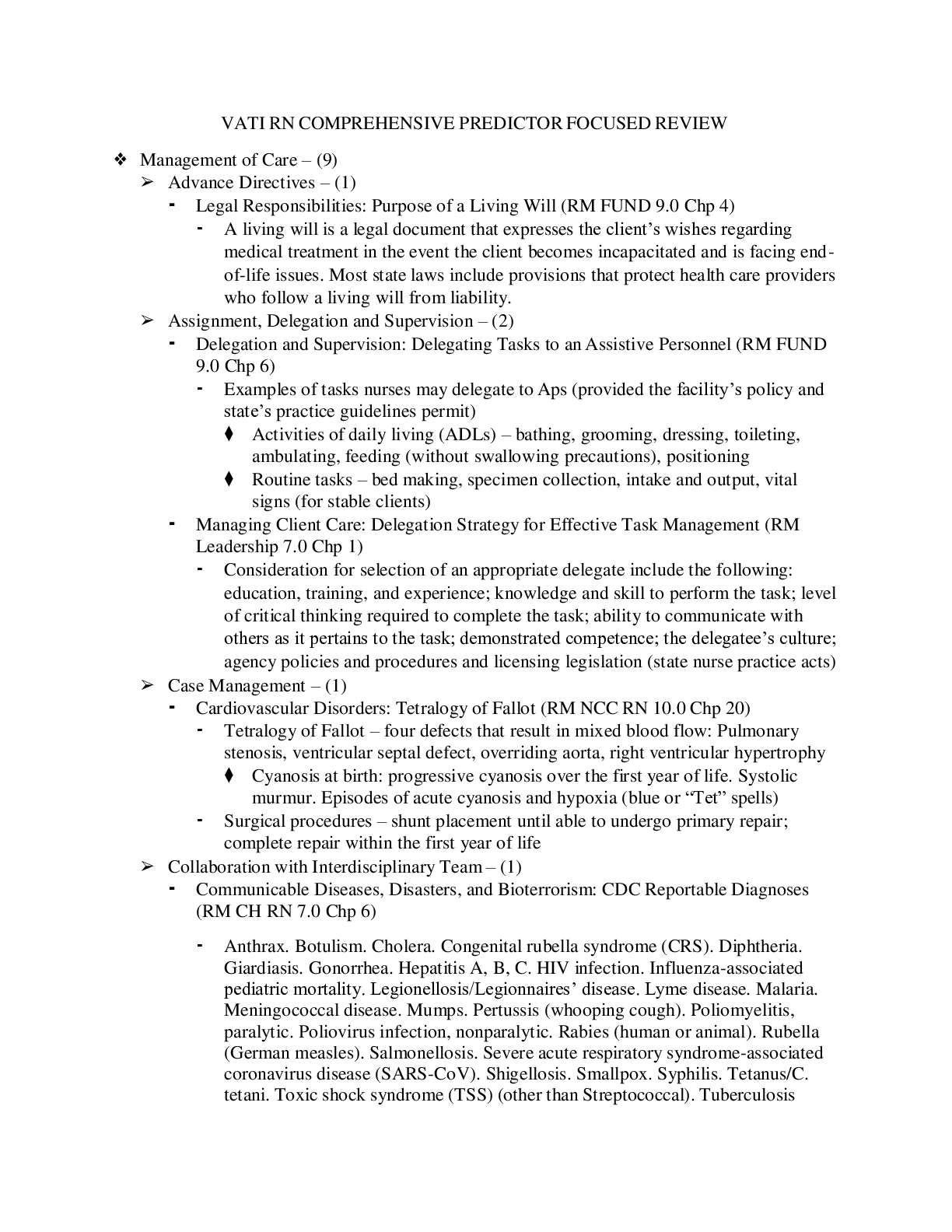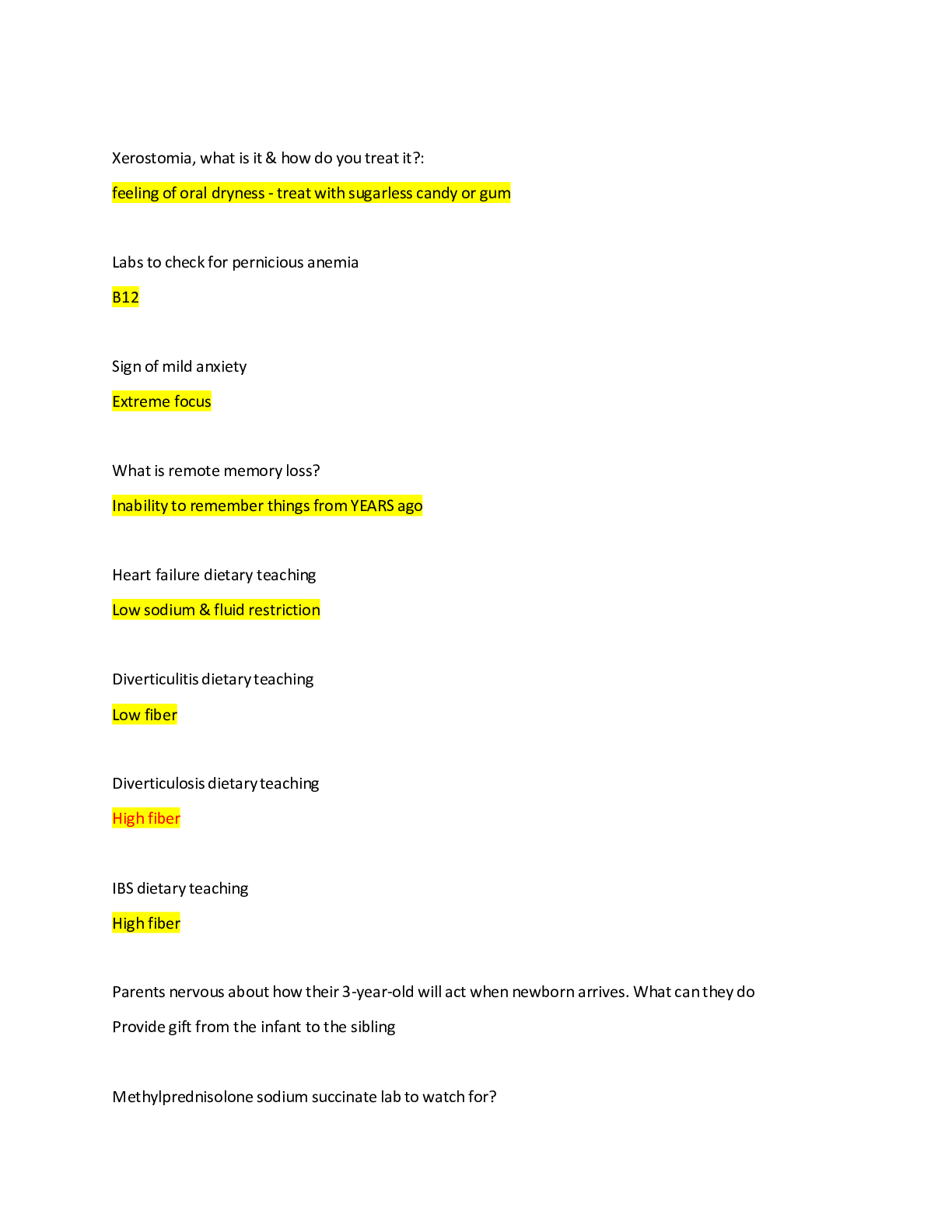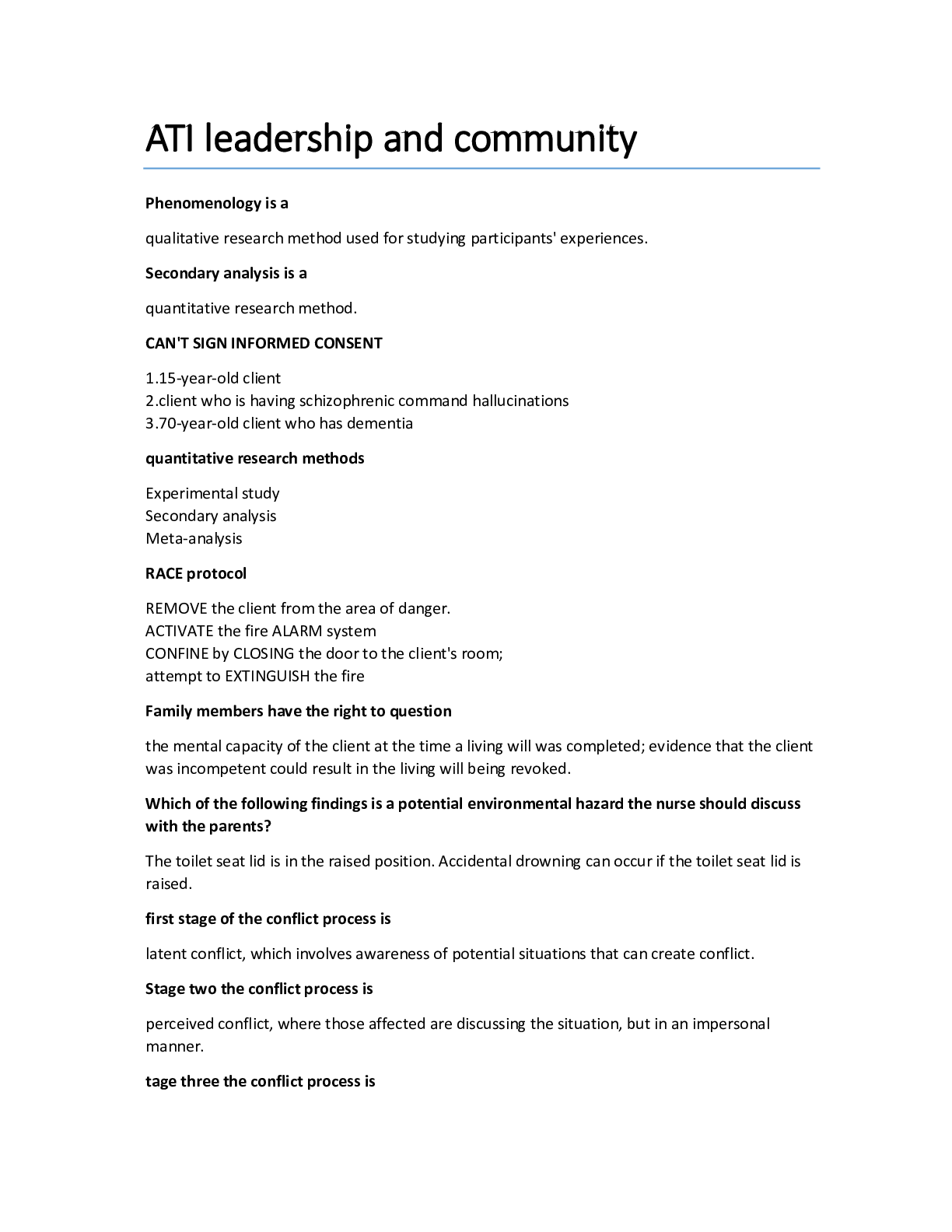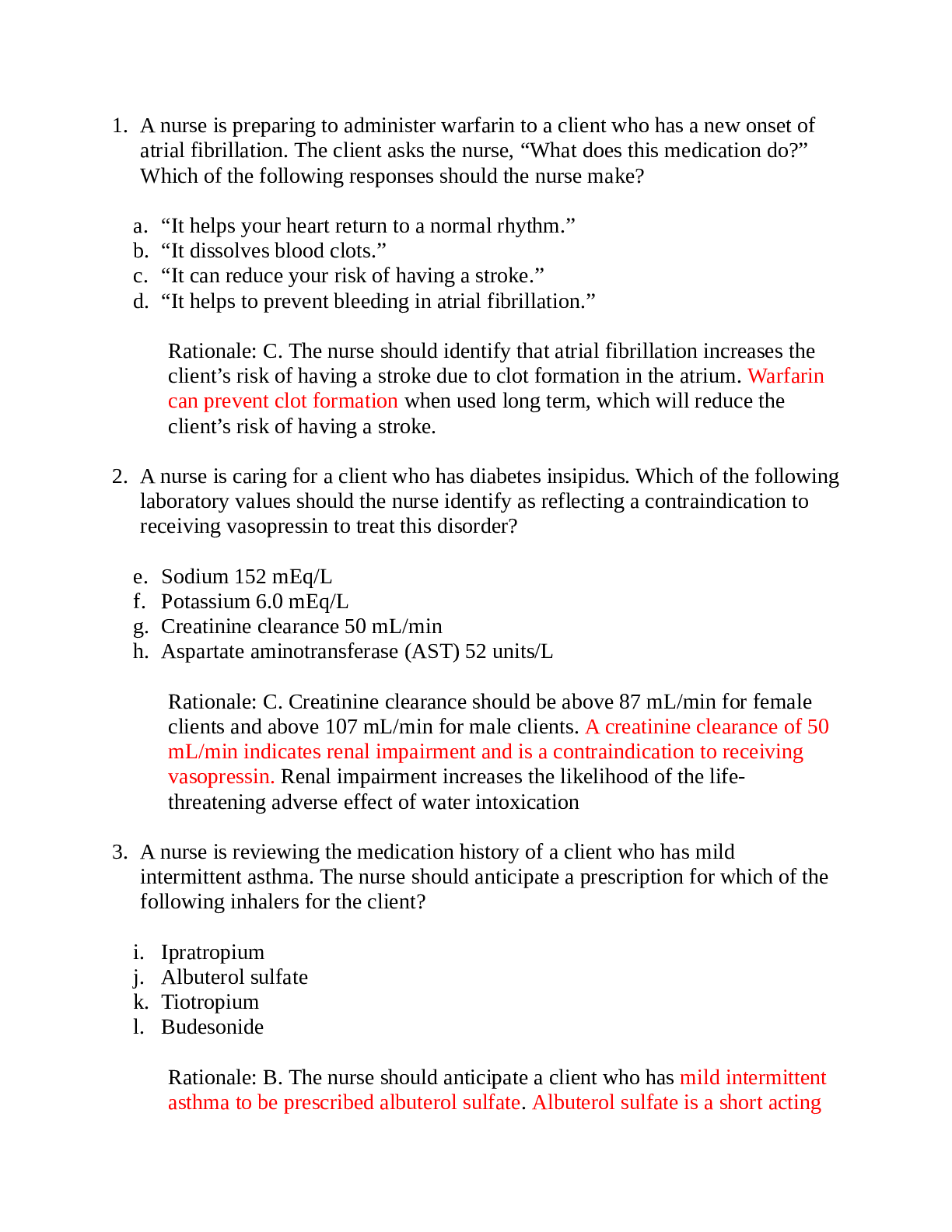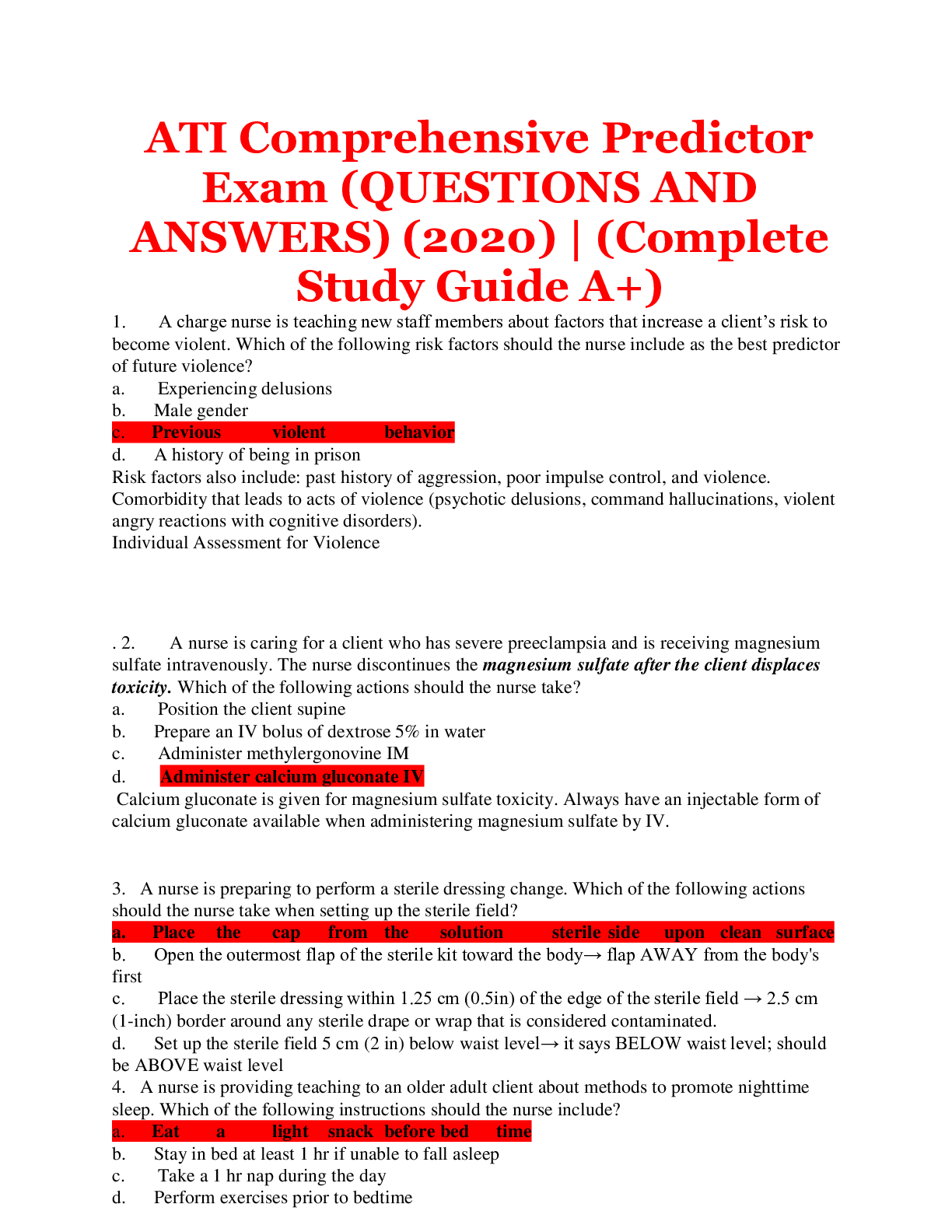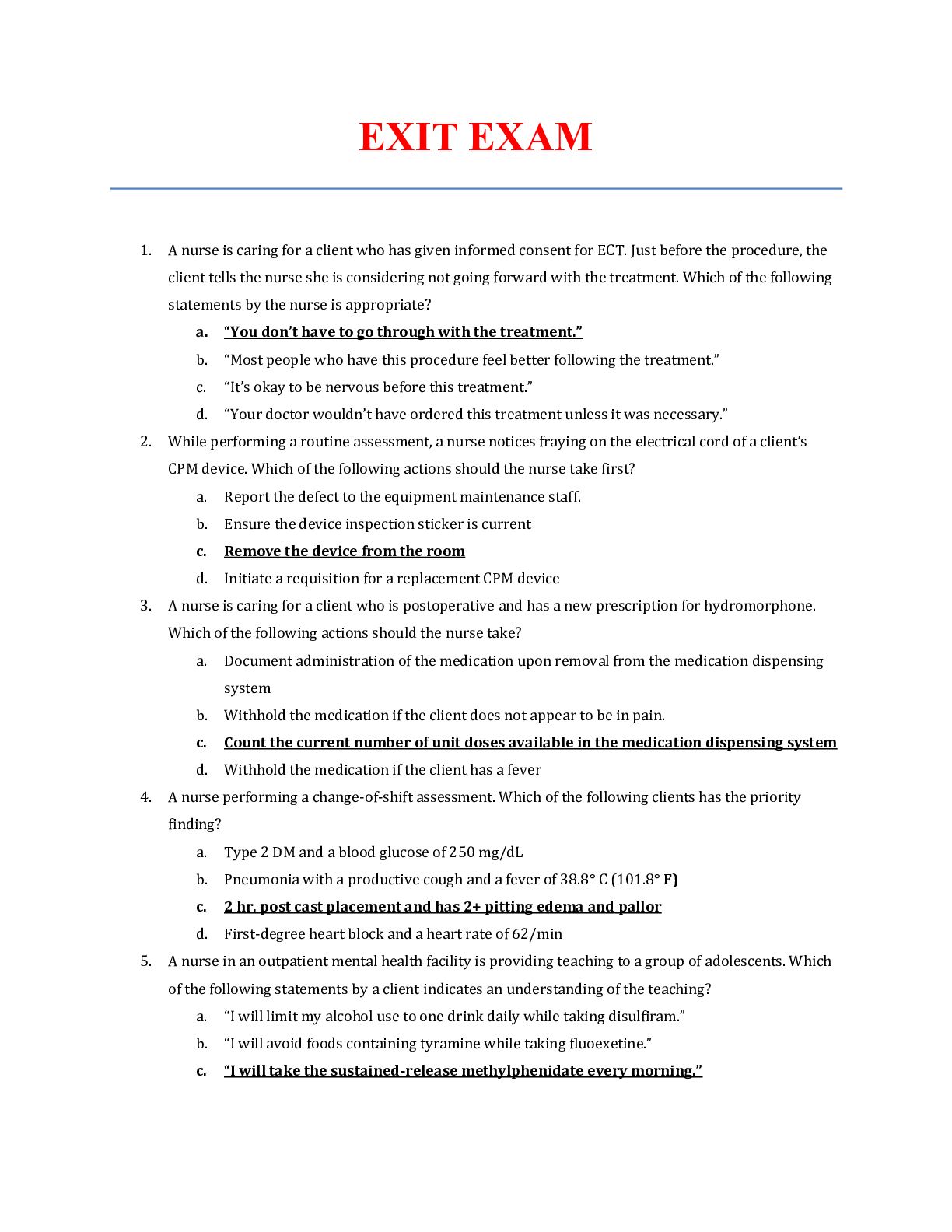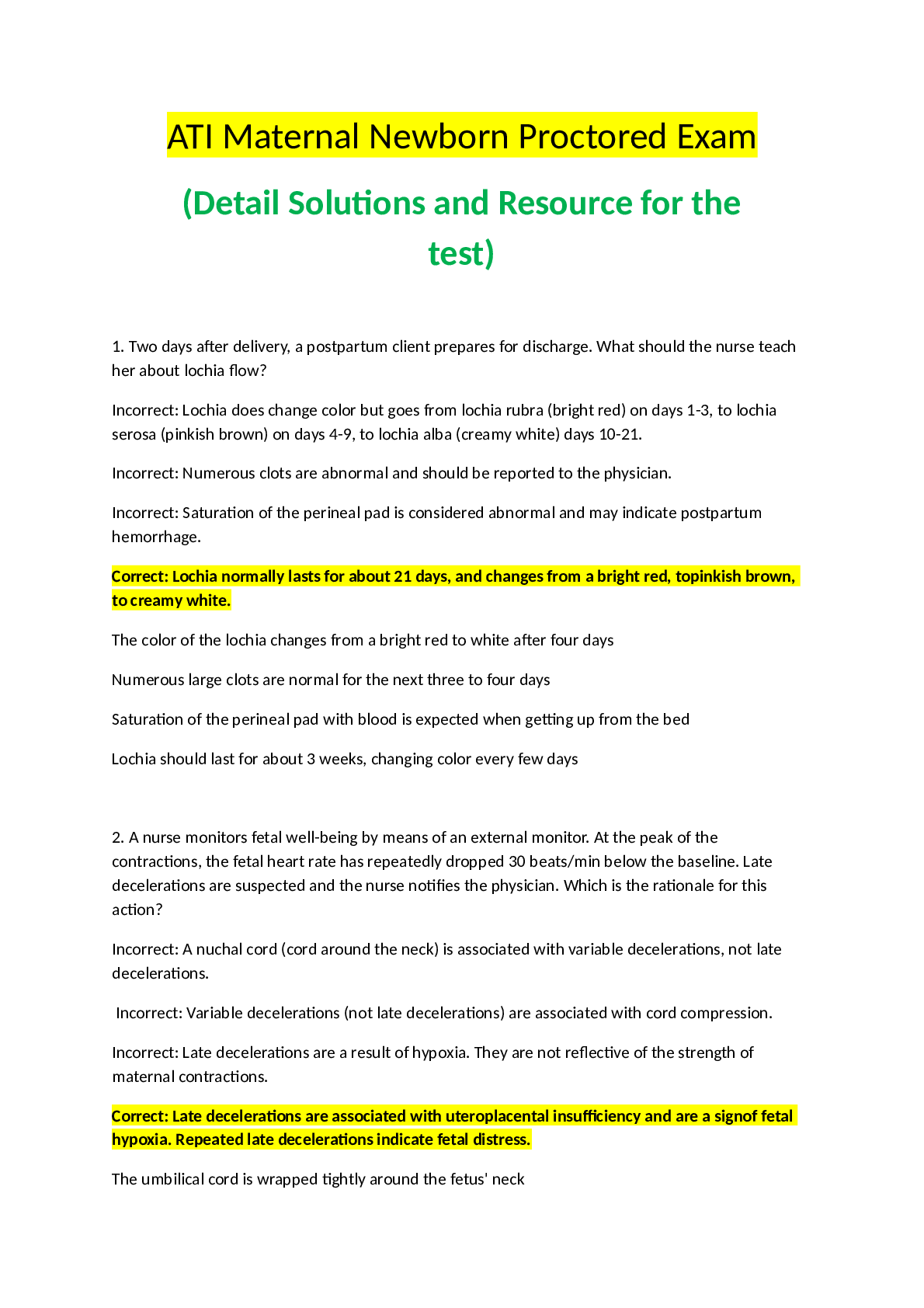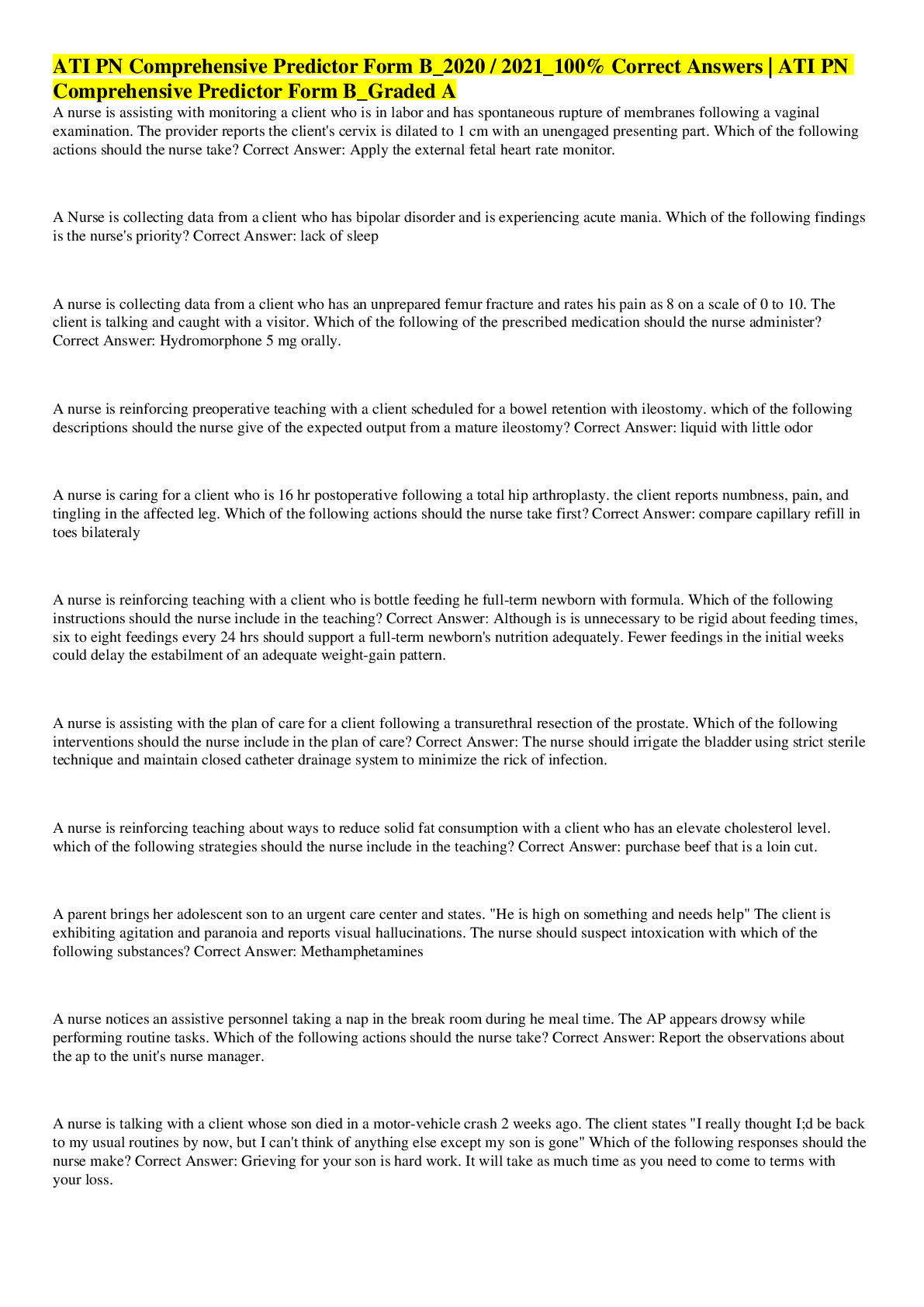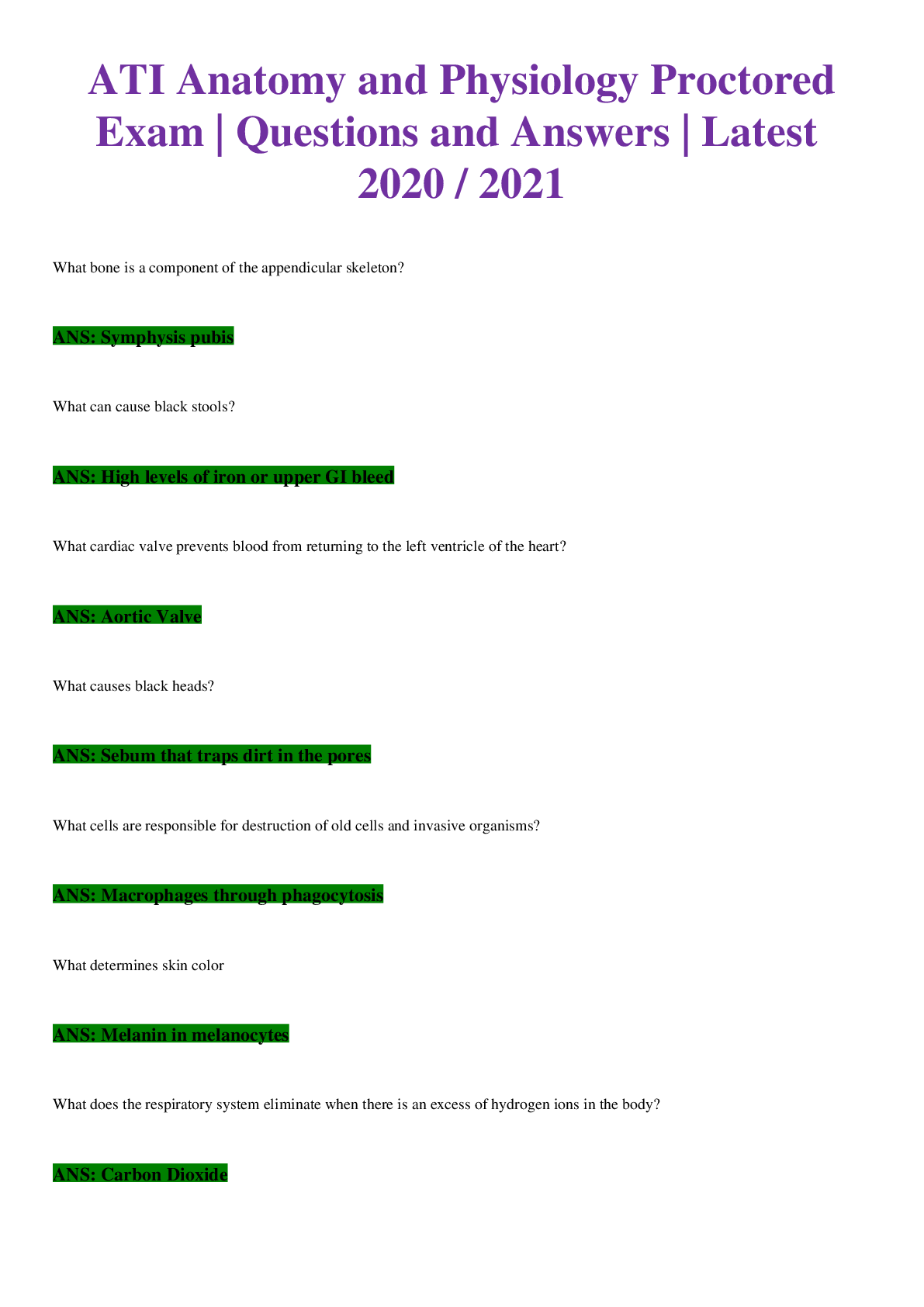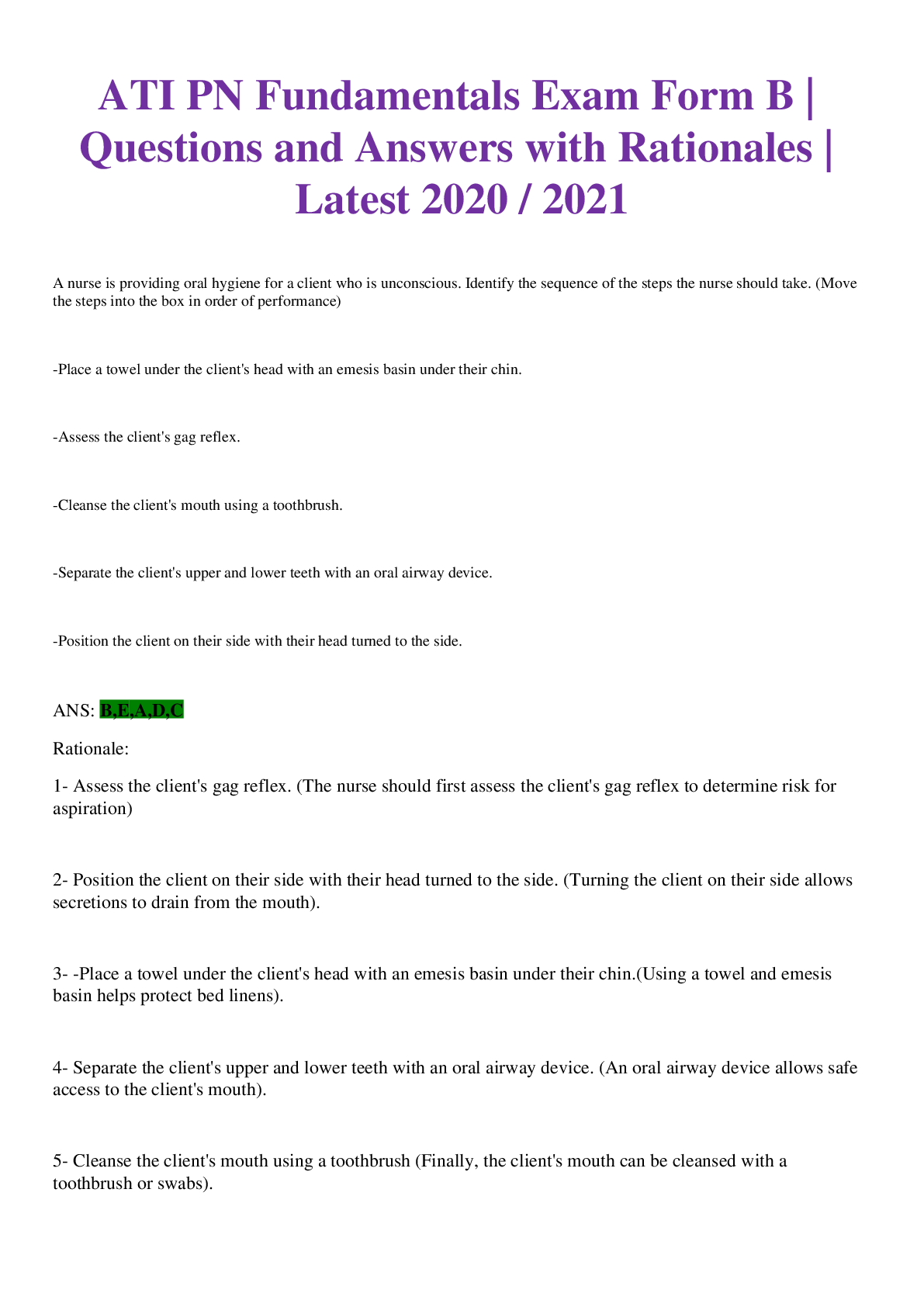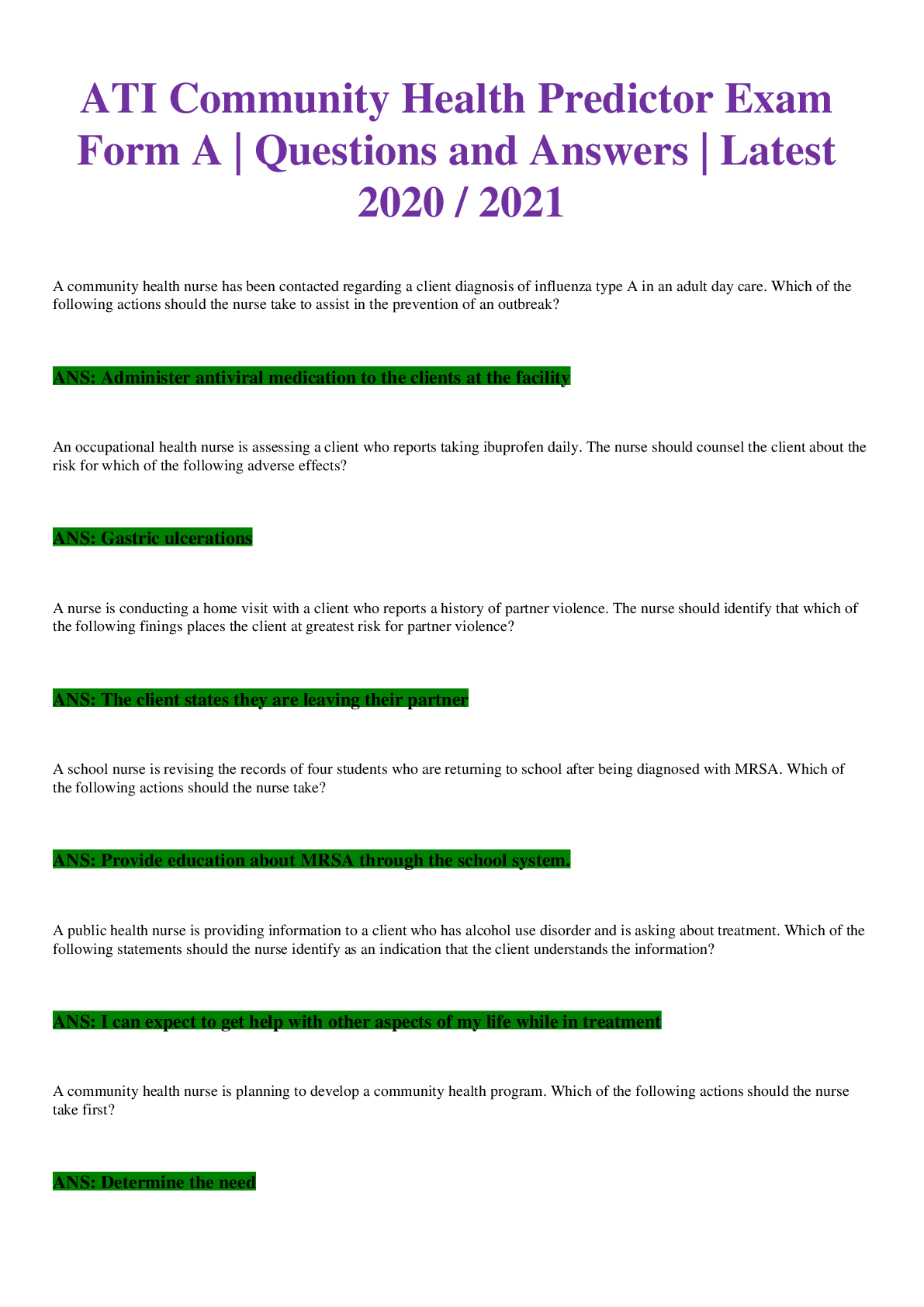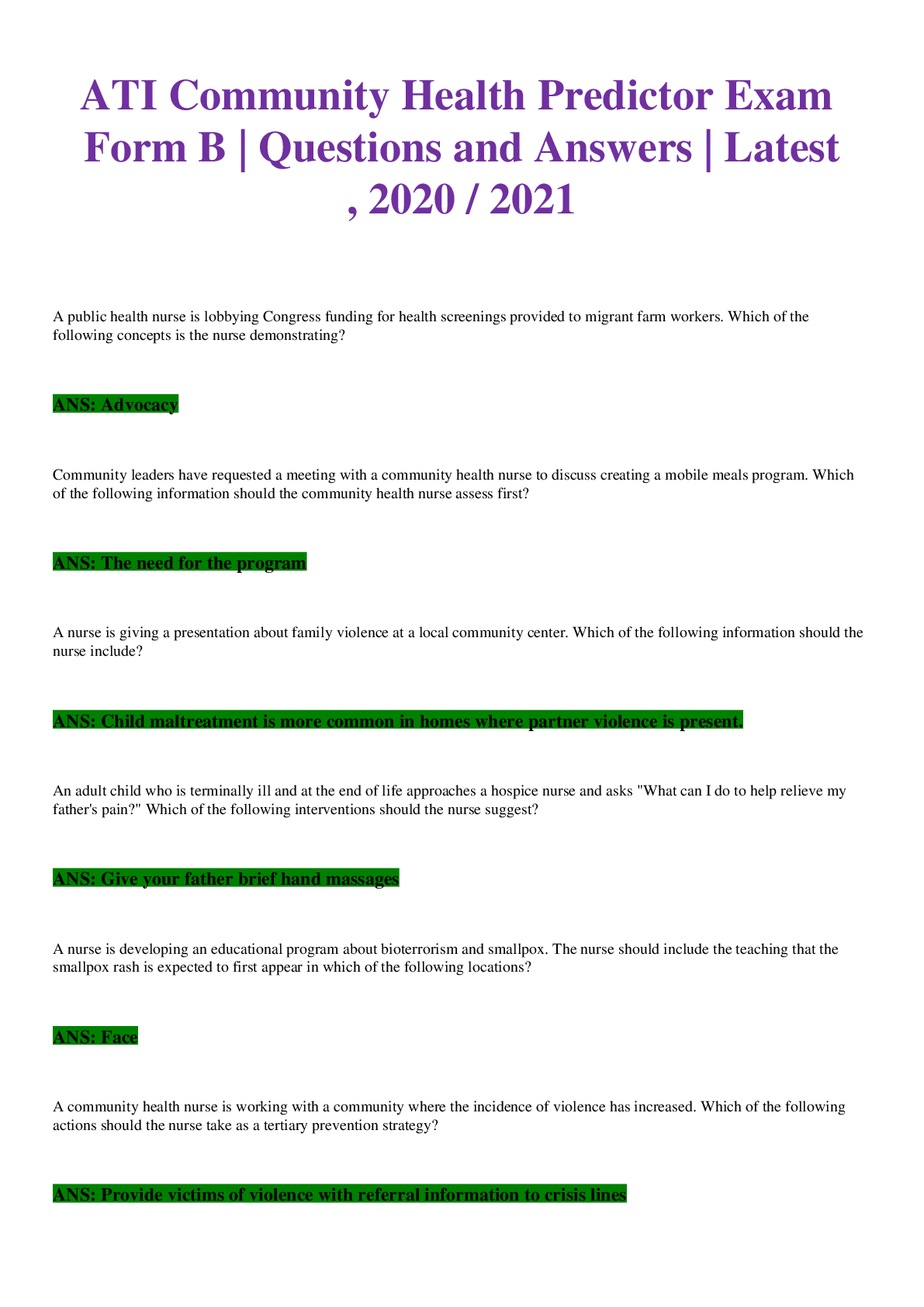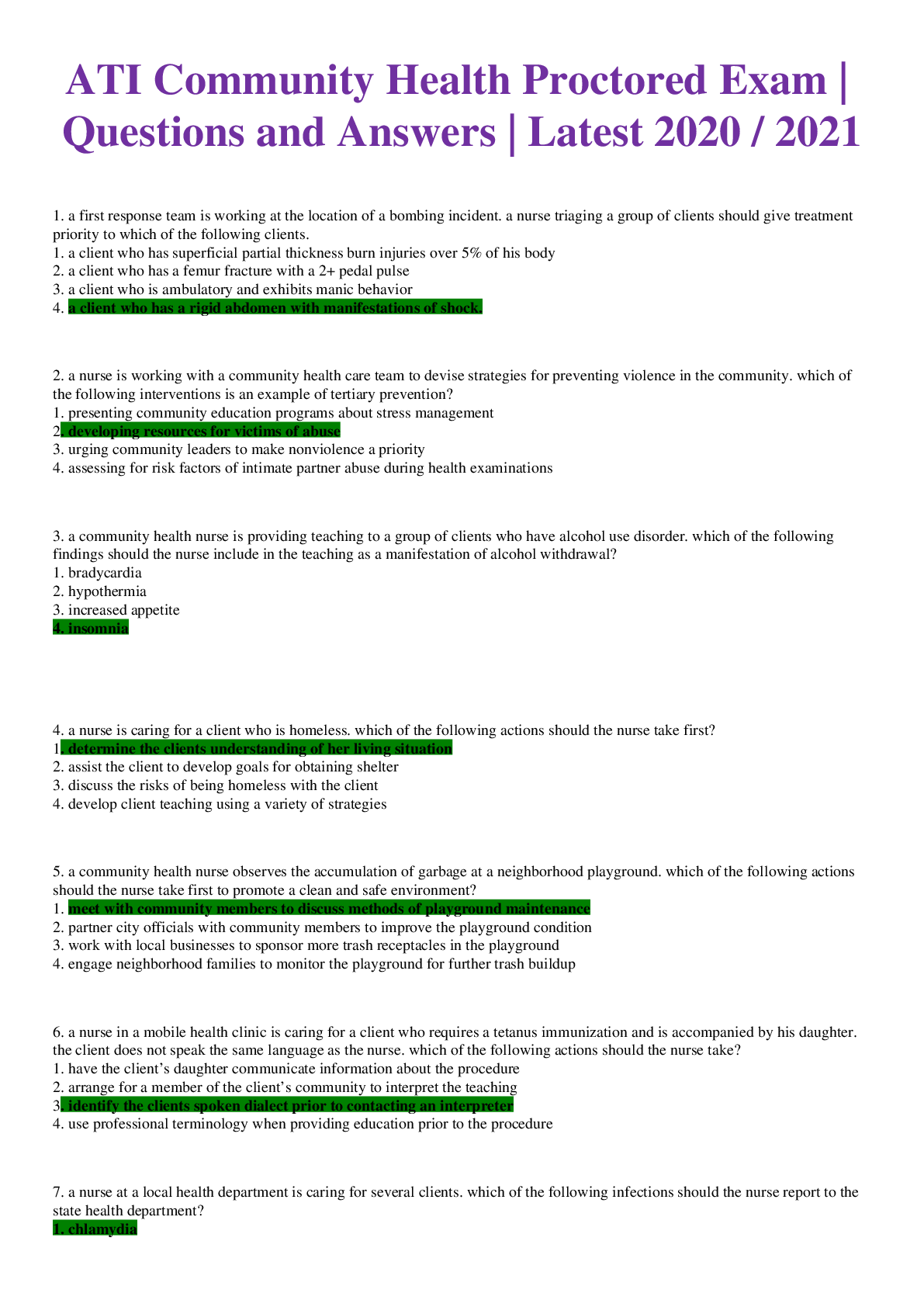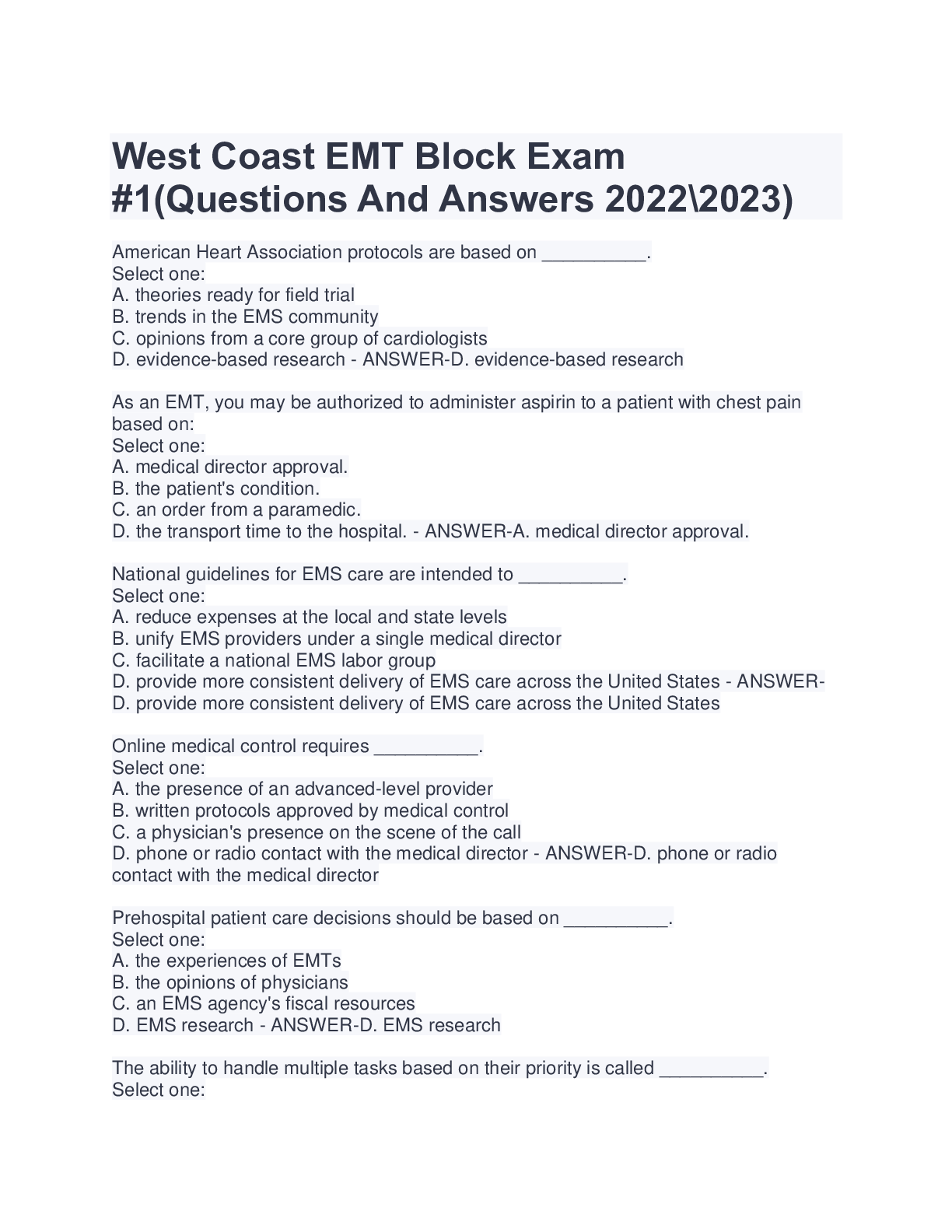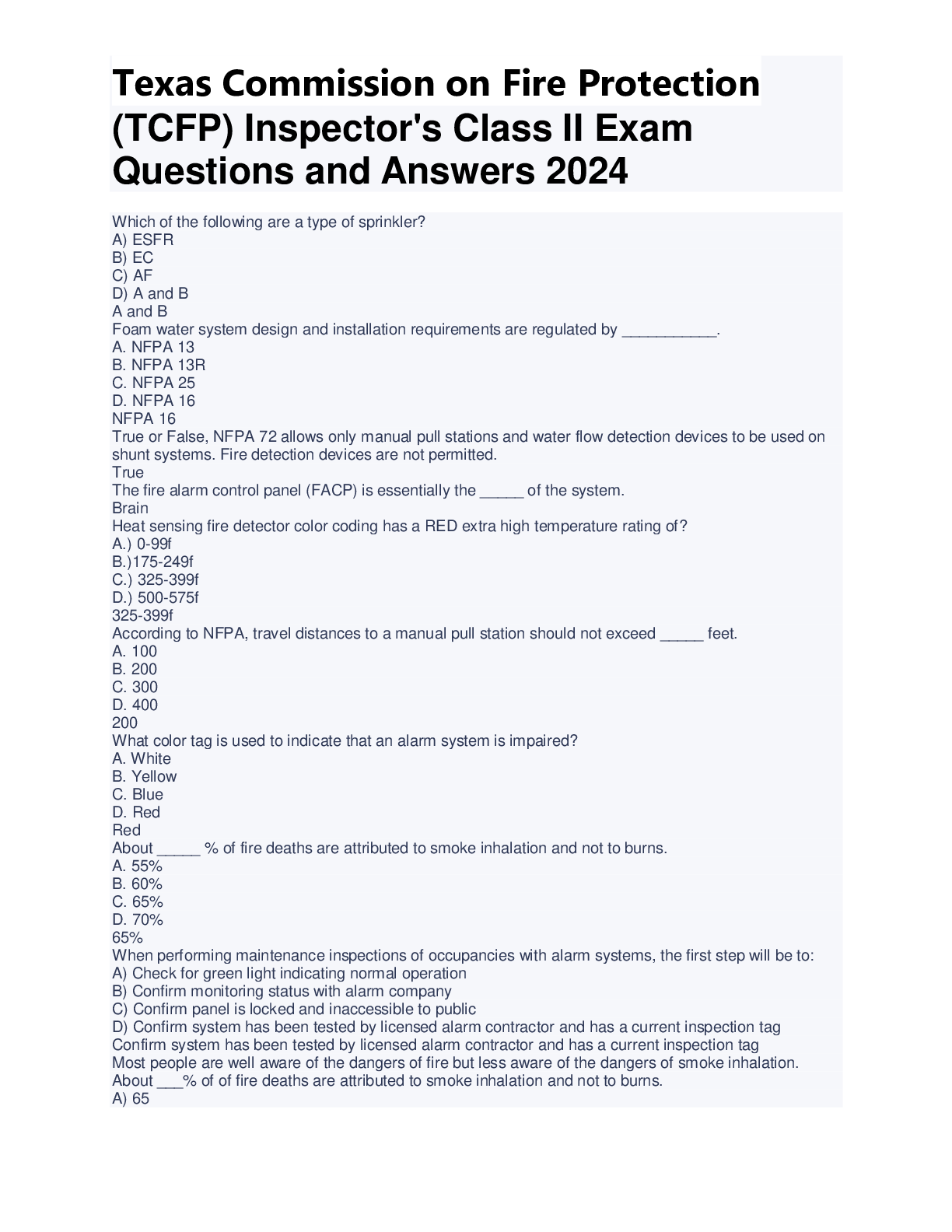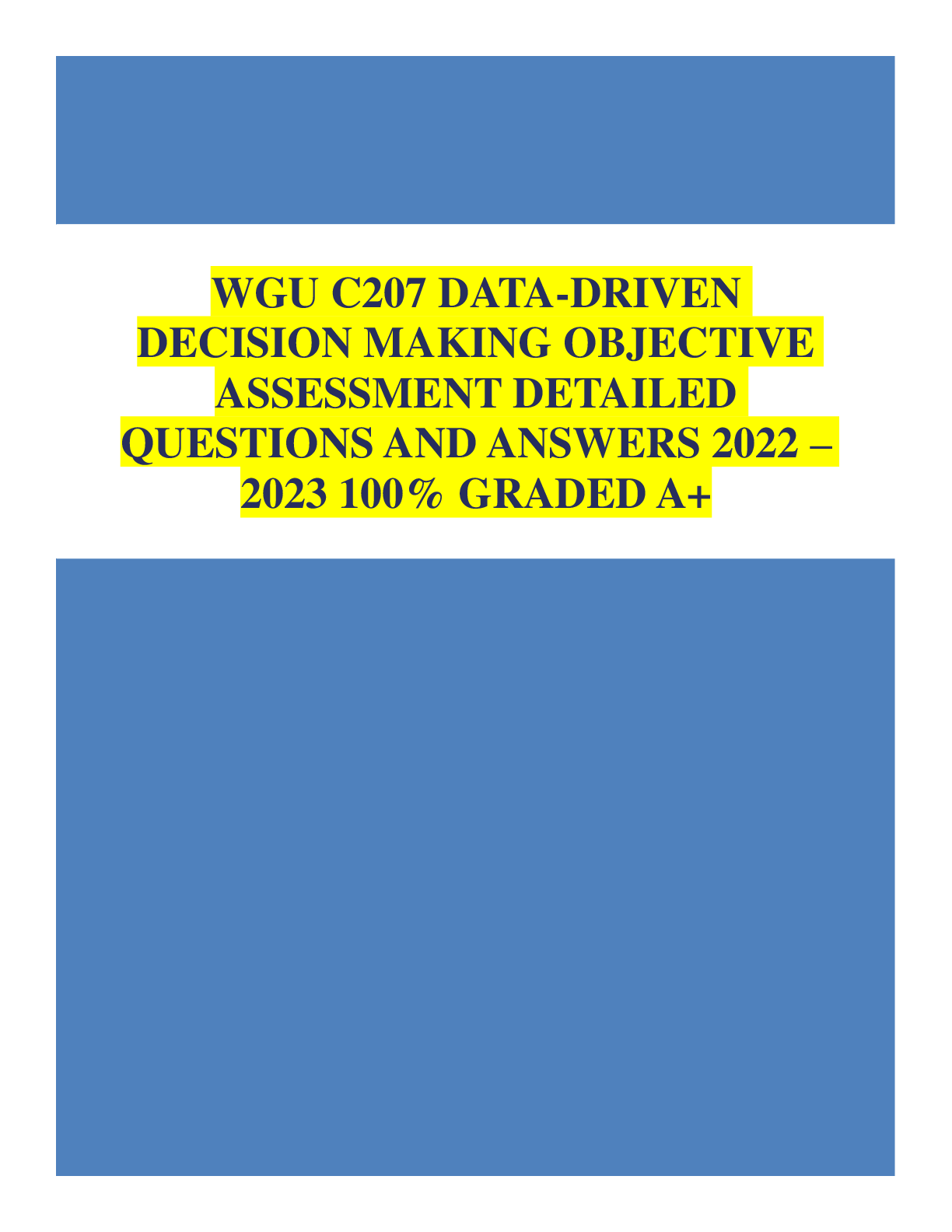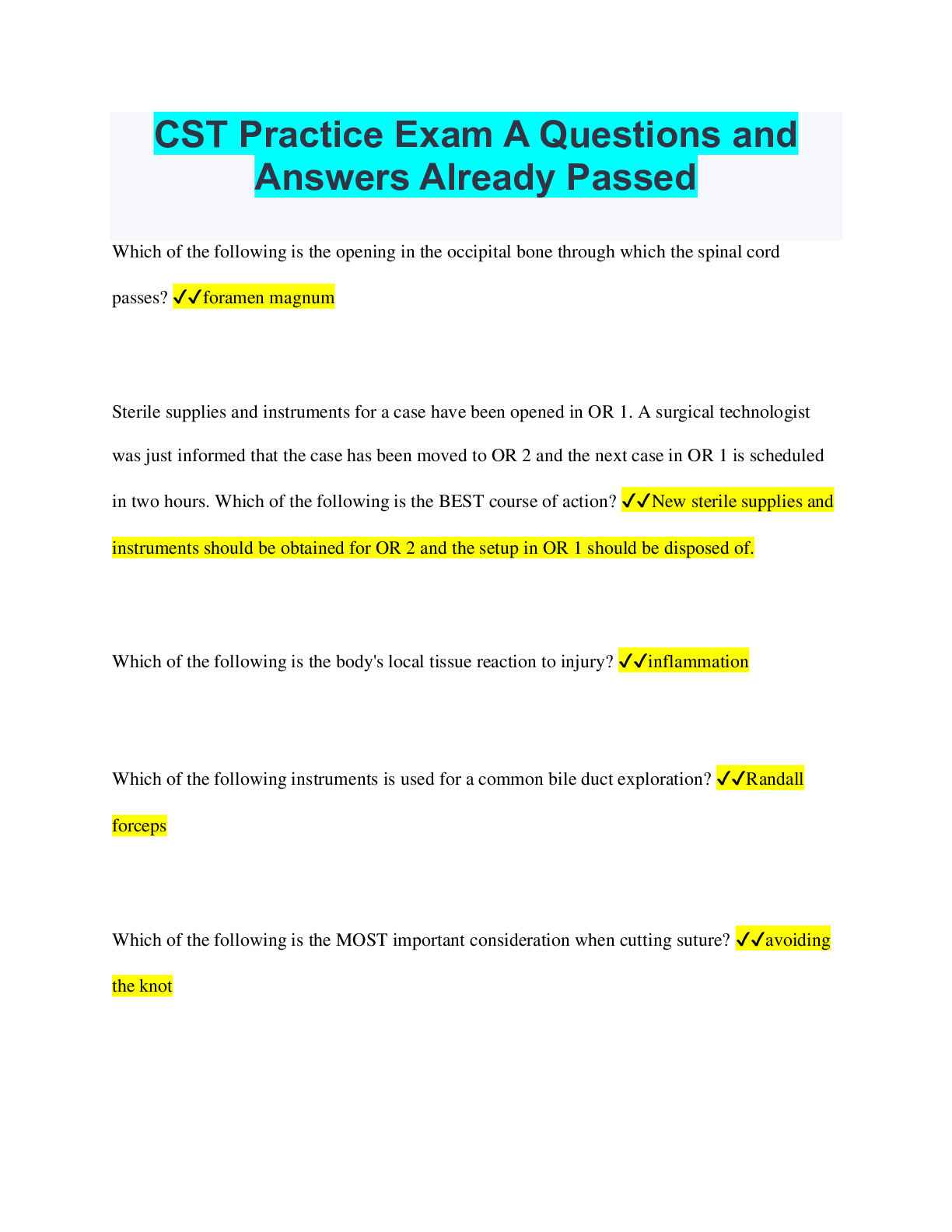*NURSING > QUESTIONS and ANSWERS > ATI Nursing Education Leadership 2016 Assessment. Detailed Answer Key (63 Questions and Answers wit (All)
ATI Nursing Education Leadership 2016 Assessment. Detailed Answer Key (63 Questions and Answers with Rationale). 100%.
Document Content and Description Below
1. A nurse is caring for a client who has metastatic cancer and has become ventilator-dependent after palliative surgery. The client wants to have the ventilator withdrawn but the client's children wa... nt the client to keep it on. The client is examined by a psychiatrist who finds that the client is competent. The nurse is aware that continued treatment against the client's wishes is a violation of which ethical principle? A. Veracity Rationale: Veracity is the "duty to tell the truth." This ethical principle is not violated. B. Autonomy Rationale: In health care, autonomy is the principle underlying informed consent, the right to refuse treatment, and the right to appoint a surrogate decision-maker. C. Fidelity Rationale: Fidelity is the "duty to keep one's promises or word." It refers to the obligation to be faithful to the agreements, commitments, and responsibilities made to oneself and others. This ethical principle is not violated. D. Nonmaleficence Rationale: Nonmaleficence is the "duty to do no harm." This ethical principle is not violated. 2. A nurse is caring for a client who has an indwelling urinary catheter and is to receive catheter care twice a day. Which of the following is the appropriate nursing action to ensure the client's privacy? A. Pull the curtain around the client's bed. Rationale: Pulling the curtain provides the most privacy for the client. With the curtain pulled, anyone entering the client's room does not have visual access to the client or the treatment being performed. B. Cover the client's genitalia with a towel while performing catheter care. Rationale: This action is inappropriate. Performing catheter care includes cleansing and inspection of the urinary meatus. This cannot be properly accomplished if the client's genitalia are covered. C. Close the door to the client's room. Rationale: Anyone can open the door and unnecessarily expose the client to the person entering the room as well as others in the hallway. D. Ask the client's roommate to leave until the treatment is finished. Rationale: This action is inappropriate. It is not necessary for the client's roommate to leave the room while catheter care is performed. 3. A nurse is caring for several clients in a walk-in clinic. Which client should the nurse have the provider see immediately? A. A belligerent, vomiting teenager with alcohol on her breath. Rationale: This client does not have a life-threatening emergency. B. A screaming toddler with a freely bleeding forehead wound. Rationale: This client does not have a life-threatening emergency. C. A diaphoretic, obese middle-aged man with epigastric pain. Rationale: This client has two of the classic signs of a myocardial infarction (MI), diaphoresis and epigastric pain. It is possible the client is having an MI. D. Young adult with painful sunburned face and arms. Rationale: This client does not have a life-threatening emergency. 4. A nurse is caring for a client with a compression fracture of a spinal vertebra. Just prior to an hour-long transport to the hospital, the client was medicated with intravenous morphine sulfate (Duramorph). On arrival, the neurosurgeon determines that urgent surgical intervention is indicated for the fracture. The nurse realizes that consent for the surgery A. must be obtained from a relative of the client. Rationale: According to the case scenario, this client was given a narcotic that can alter the ability to understand within the subsequent 1 to 2 hr. Consequently, this client is not legally able to provide consent. B. can be inferred since the client consented to the transport. Rationale: Consent for transfer to another facility for evaluation by a specialist does not imply consent for any further procedures or care. C. should be obtained from the client immediately. Rationale: This client was given a narcotic that can alter the ability to understand within the subsequent 1 to 2 hr. Consequently, this client is not legally able to provide consent. D. will be delayed until the morphine is metabolized. Rationale: Delaying consent until the morphine is metabolized could be dangerous to the client and may increase the chance of a life-long disability. 5. An assistive personnel (AP) comes to work with a new set of highly polished acrylic nails. The nurse takes the AP aside and explains that acrylic nails are not permitted on the health care unit. Which of the following statements should the nurse tell the AP? A. "There is a higher risk of infection associated with acrylic nails." Rationale: Studies have shown that the wearing of acrylic nails is associated with an increased risk of infection. It is more difficult to perform adequate handwashing with acrylic nails and microorganisms can hide in small chips in the polish. In addition, acrylic nails make it more difficult to apply gloves properly and can increase the risk of tearing of the tips. B. "Polished acrylic nails have a very unprofessional appearance." Rationale: This is not the reason that acrylic nails are prohibited in the health care setting. C. "Acrylic nails may contribute to contact dermatitis." Rationale: This is not the reason that acrylic nails are prohibited in the health care setting. D. "Acrylic nails can break and injure the client." Rationale: This is not the reason that acrylic nails are prohibited in the health care setting. 6. A nurse is caring for a client who is scheduled to have surgery. In preparing the client for surgery, which of the following actions is considered outside the responsibility of the nurse? A. Assess the current health status of the client. Rationale: This action is a nursing responsibility that helps collect baseline data on the client. B. Explain the operative procedure, risks, and benefits. Rationale: Explaining the procedure and any risks that may be associated with the procedure is the responsibility of the person performing the procedure. This is not a nursing responsibility. C. Review preoperative laboratory tests results. Rationale: This action is a nursing responsibility that determines if any abnormal values could cause surgical complications. D. Ensure that a signed surgical consent form was completed. Rationale: This action is a nursing responsibility that ensures proper surgical protocol is carried out. 7. A nurse takes the witness stand in a malpractice suit. While on the witness stand, the nurse states to the court, "any reasonable and prudent nurse would have questioned that order." In this situation, which of the following types of witness is the nurse testifying as? A. Defense Rationale: The case scenario does not give you enough information to determine if the nurse was giving testimony on the behalf of either the defense or the prosecution. B. Expert Rationale: The nurse in this situation is offering a professional opinion about a standard of practice: what a reasonable and prudent nurse would do in that same circumstance. A nurse, acting as an expert C. Character witness, is one who has a special skill, advanced education, or is part of a nursing specialty and is allowed by the court to offer an opinion based on professional expertise. Rationale: Character witnesses provide information describing the overall nature of a person, based on past experience and knowledge of that person's actions. D. Prosecution Rationale: The case scenario does not give you enough information to determine if the nurse was giving testimony on the behalf of either the defense or the prosecution. 8. A family member who is the primary caregiver of a client with multiple care needs is interested in a respite care program. The nurse should explain that the primary purpose of a respite care program is to provide which of the following? A. Pain management Rationale: This is not the primary purpose of a respite program. B. Temporary care Rationale: The primary purpose of respite is to give family members time and temporary relief from the stress they may experience while providing extra care for a family member with a disability. C. Palliative care Rationale: This is not the primary purpose of a respite program. D. Restorative care Rationale: This is not the primary purpose of a respite program. 9. A nurse reported to the nurse manager that another staff member was observed signing out meperidine hydrochloride (Demerol), which was not administered to the client. The nurse manager should know that potential opiate abuse by the employee may be manifested by which of the following symptoms? A. Tremors Rationale: Demerol is a synthetic narcotic analgesic. Tremors result from a buildup of normeperidine when repeated doses are given. B. Rhinorrhea Rationale: Rhinorrhea may occur with opiate withdrawal but is not an effect from the medication. C. Pale skin color Rationale: Pale skin color is not an effect of this medication. Integumentary effects include flushing. D. Dilated pupils Rationale: Pupillary changes that may be observed in opiate abuse would be constricted pupils, not dilated pupils. 10. A nurse is caring for a client who has constipation, and a soap suds enema is prescribed. As the nurse explains the procedure, the client states, "The doctor didn't tell me I was supposed to receive an enema." Which of the following nursing actions is appropriate at this time? A. Check the client's chart for the provider's prescription. Rationale: This option directly addresses the client's concern about whether or not an enema is prescribed. Looking at the provider's prescription will help to clarify the situation and will reassure the client that the procedure was prescribed. B. Explain to the client that the provider prescribed the procedure. Rationale: This option ignores the client's concern about whether or not an enema is prescribed. C. Assure the client that enemas are commonly prescribed for constipation. Rationale: This option ignores the client's concern about whether or not an enema is prescribed. D. Inform the charge nurse that the client refused the enema. Rationale: The client did not refuse the enema, so this action would be incorrect. 11. A nurse is caring for several clients on the unit. In which of the following situations is the nurse permitted to disclose information to an outside agency about the client or the client's circumstances? A. An older adult is admitted for the treatment of a spiral fracture. Rationale: This situation reflects elder abuse. Nurses are mandatory reporters of any client situation in which children or the elderly are being abused or neglected. B. A client is admitted for asthma and has track marks that may indicate IV drug abuse. Rationale: Although the use of street drugs is illegal, the track marks may be present from scarring due to prior use. The nurse would not be required to report this finding to law enforcement. C. A football star is admitted following a knee injury. Rationale: Information about the client's status and treatment cannot be shared outside of the health care team caring for this client without his permission. D. A local politician is admitted to an alcohol rehabilitation facility. Rationale: Information about the client's status and treatment cannot be shared outside of the health care team caring for this client. 12. A nurse is caring for several patients. The nurse should know that which of the following conditions makes a client an unsuitable organ donor? A. Older than age 65 Rationale: Age is not an automatic exclusion criterion, and most transplant centers will evaluate potential donors from newborn to 80 years old. B. Metastatic malignancy Rationale: The only clients who are always excluded from organ or tissue donation are those who have metastatic malignancies or communicable diseases such as hepatitis and human immunodeficiency virus. C. Advanced cardiovascular disease Rationale: Although advanced cardiovascular disease may preclude the donation of some organs, it is not an automatic exclusion criterion. D. Type 1 diabetes mellitus Rationale: Although long-standing diabetes may preclude the donation of some organs, it is not an automatic exclusion criterion. 13. A nurse in the intensive care unit is caring for a client who has a tracheostomy and is on a ventilator. The client also has an indwelling urinary catheter to gravity drainage and a central venous catheter, and is on a heparin drip for a thrombophlebitis of the left leg. Which of the following specimens can the nurse delegate to assistive personnel (AP) to collect? A. Blood culture Rationale: Obtaining a blood culture is not within the scope of practice for an AP. B. Sputum culture Rationale: Collecting a sputum sample is not within the scope of practice for an AP. C. Arterial blood gas (ABG) Rationale: Collecting an ABG sample is not within the scope of practice for an AP. D. Fecal occult blood Rationale: Collecting a stool sample is within the scope of practice for an AP. 14. A hospital is participating in a disaster simulation in which a toxic substance is released into a crowded stadium. Multiple clients are transported to the hospital. Which of the following activities would be of lowest priority for the triage nurse in the event of a disaster? A. Preventing cross-contamination of clients Rationale: In a disaster, the nurse must be able to segregate clients to prevent contamination of a non-exposed client by an exposed client, thereby limiting the spread of an unknown toxin. B. Performing concise client assessment Rationale: In the triage setting, the nurse's priority is client assessment and control of client flow. C. Educating the client and family Rationale: The triage nurse should not use the limited time available with each client to provide education. Other health care team members will do this once treatment of the client is initiated. D. Maintaining calm amidst the chaos Rationale: The nurse should direct client flow in a calm, professional, and orderly manner in order to maintain a therapeutic environment for client care. 15. A nurse is caring for a client. The nurse demonstrates adherence to the ethical principle of fidelity in practice by doing which of the following? A. Keeping an appointment with a client. Rationale: Fidelity is the duty to keep one's promises or word. Keeping an appointment that the nurse has made with the client is an example of fidelity. B. Allowing a new mother to hold her stillborn infant. Rationale: Beneficence is the duty to do good for others. Allowing a grieving mother an opportunity to spend time with her infant helps her to process her loss and is an example of beneficence. C. Confirming that a client going for surgery has signed a consent form. Rationale: The ethical principle of autonomy describes an individual's right to choose. In health care, autonomy is the principle underlying informed consent, the right to refuse treatment, and the right to appoint a surrogate decision maker. D. Refusing to disclose information about a client to the media. Rationale: Confidentiality means that a client's personal health care information cannot be disclosed to unauthorized individuals or other entities. 16. A nurse is working with an assistive personnel (AP) to care for a group of clients on the pediatric floor. Which task should the nurse have the AP perform first? A. Collect a stool sample for ova and parasites from a 2-year-old child. Rationale: Although elimination is an important physiologic need, the nurse uses Maslow's Hierarchy of Needs as a guideline to identify a client with a more immediate need. The stool sample should be collected when available and sent to the laboratory for analysis. B. Ambulate a postoperative 5-year-old child to the playroom. Rationale: Although ambulation is an important physiologic need, the nurse uses Maslow's Hierarchy of Needs as a guideline to identify a client with a more immediate need. C. Assist the nurse in bathing a 14-year-old child who has a handicap. Rationale: Although provision of skin care is an important physiologic need, the nurse uses Maslow's Hierarchy of Needs as a guideline to identify a client with a more immediate need. D. Feed a 9-year-old child with bilaterally burned upper extremities. Rationale: In prioritizing the list of tasks, the nurse should have the AP perform the tasks that meet basic physiologic needs first. Using Maslow's Hierarchy of Needs as a guideline, the nurse should know that the client who needs to be fed is the most basic physiologic need listed. 17. Following a suicide bombing at a shopping mall, an unidentified, unconscious client is admitted to the emergency department with an acute intra-abdominal hemorrhage. The nurse should recognize that consent for the surgery A. should be obtained from an officer of the court. Rationale: Awaiting legal intervention could mean an inordinate delay until surgery is performed. B. must be obtained from a relative of the client. Rationale: In urgent situations, it is preferable for consent to be obtained from a relative or health care proxy (HCP). However, in this situation, the next of kin cannot be readily identified. C. can be inferred since the client is in critical condition. Rationale: The client is unconscious and in critical condition, and consequently, is incapable of providing consent. Preferably, consent should be obtained from a relative or health care proxy (HCP). However, the client is also unidentified, meaning the client could die while awaiting identification and next of kin. Therefore, consent should be implied and the surgery will be performed as an emergency life-saving procedure. D. will be delayed until the client is identified. Rationale: This is not an appropriate action. The client could die awaiting identification and next of kin. 18. A nurse is speaking to the nurse manager about a schedule request, and the nurse manager puts an arm around the nurse and says, "I bet you are a great lover." Which of the following is the appropriate response by the nurse? A. "Let's talk about something else." Rationale: While this appears to be a response meant to change the subject, this response does not make it clear that this type of sexually oriented conversation and physical contact is undesired by the nurse. B. "Whether or not I am a good lover is irrelevant." Rationale: While this appears to be a response meant to change the subject, this response does not make it clear that this type of sexually oriented conversation and physical contact is undesired by the nurse. C. "Speaking to me like that makes me uncomfortable." Rationale: This assertive response makes it clear that this type of sexually oriented conversation and physical contact is undesired by the nurse. D. "That is not what I am here to discuss." Rationale: While this appears to be a response meant to change the subject, this response does not make it clear that this type of sexually oriented conversation and physical contact is undesired by the nurse. 19. A female teen volunteer is assigned to the pediatric unit for the day and reports to the charge nurse for an assignment. Which of the following assignments is unsafe for the volunteer? A. Helping a 7-year-old client who has celiac disease make out the next day's menu Rationale: The volunteer may not be familiar with the dietary needs of a client with celiac disease. B. Playing a computer video game with a 15-year-old male client in skeletal traction Rationale: This is an appropriate and safe assignment for the volunteer that provides both socialization and diversional activity to the client in traction. C. Reading a book to a 4-year-old client who has AIDS Rationale: This is an appropriate and safe assignment for the volunteer that provides a diversional activity for the client. D. Refilling the ice pitchers for clients on the unit for the charge nurse Rationale: Refilling the ice pitchers for clients on the unit for the charge nurse is an appropriate and safe assignment for the volunteer to do under the supervision of the charge nurse. 20. When checking on a confused client, a nurse finds that the client has fallen out of bed after climbing over the side rails. After determining that the client is uninjured, the nurse assists the client back to bed and contacts the provider to assess the client. The nurse then completes a variance report detailing the incident. Which of the following should be the next nursing action the nurse completes? A. Make a copy of the variance report for the provider. Rationale: Variance reports are confidential tools used by the institution to improve client care. They are never copied. B. Submit the variance report to the nurse manager. Rationale: Variance reports are confidential tools used by the institution to improve client care. They are never copied, placed in, or referred to in a client's chart. Filing a variance report does not substitute for a complete entry in the client's chart documenting the incident. Once completed, the variance form is submitted to the nurse's most immediate supervisor such as the nurse manager. C. Place the variance report in the client's chart. Rationale: Variance reports are confidential tools used by the institution to improve client care. They are never placed in the client's chart. D. Document in the chart that a variance form has been filed. Rationale: Variance reports are confidential tools used by the institution to improve client care. They are never referred to in a client's chart. 21. A nurse manager notices that a nurse in the unit is not delivering care in accordance with a recent policy change. The effective approach for the nurse manager to take is to A. encourage the nurse to openly verbalize the reasons for resistance to the change. Rationale: The nurse manager should realize that resistance to change is likely if the people who must implement the change are not invested in the change process. The nurse manager should meet with the nurse to allow an open forum for the nurse to verbalize the reasons for reluctance to adopt the new policy. B. explain to the nurse the importance of implementing the new policy. Rationale: The nurse has likely rejected the change without critically thinking about the possible benefits; this is not the appropriate action by the nurse. C. ignore the resistance and allow peer pressure to facilitate change in the nurse's behavior. Rationale: The nurse manager should not ignore an individual who is refusing to implement a policy change. The nurse may act as a barrier to the change. D. threaten disciplinary consequences if the nurse does not implement the new policy. Rationale: Starting the meeting with a discussion of disciplinary consequences is unlikely to encourage open dialogue. 22. A nursing supervisor assigns a float nurse in an adult medical-surgical unit to work in a pediatric unit. This is the nurse's first time in a pediatric setting. Which of the following is an appropriate assignment for the nurse? A. Care for postoperative school-age clients. Rationale: Hospitalized school-aged children tend to have similar medical-surgical diagnoses to adults and are in an age group that is easier to care for than younger children or adolescents. The float nurse should be able to handle this assignment with minimal guidance. B. Function as an assistive personnel (AP). Rationale: Functioning as an AP is an inefficient use of the RN's skills. C. Shadow an experienced pediatric nurse. Rationale: Shadowing an experienced nurse will not meet the needs of the unit. D. Assist the unit clerk at the nurse's desk. Rationale: Functioning as a unit clerk is an inefficient use of the RN's skills. 23. A nurse is caring for a client who is preoperative. The nurse signs as a witness on the client's procedural consent forms. By signing as a witness, the nurse is verifying that A. the client understands the risks and benefits of the procedure. Rationale: The legal responsibility for explaining and ensuring the client's understanding of the procedure rests with the provider who will be performing that procedure. B. it was the client who signed the consent form. Rationale: By signing as a witness on a procedural consent form, the nurse is confirming that the client was the one who signed the consent form. C. the client has no unanswered questions about the procedure. Rationale: The legal responsibility for explaining and ensuring the client's understanding of the procedure rests with the provider who will be performing that procedure. D. the provider informed the client about the risks and benefits of the procedure. Rationale: It is not a nursing responsibility to monitor the thoroughness of the provider's explanation. The nurse should ensure that the client understands what the provider said so the obtained consent is informed. 24. Following a tornado, a nurse is determining which of the clients assigned to her care can be discharged to free up beds for injured clients. The nurse should determine that, of the four clients assigned, it is possible to discharge a client who A. has chronic Crohn's disease and is 1 day preoperative for an ileostomy. Rationale: An ileostomy is performed to remove diseased bowel, but this is considered an elective surgery and can be postponed in an emergency. B. is 3 days postoperative following a lobectomy and has a chest tube scheduled to be removed today. Rationale: Following chest tube removal, the client should have an immediate chest x-ray to detect any new or residual lung collapse and should remain hospitalized for observation for at least 24 hr. Therefore, this client should not be discharged. C. is 2 days postoperative following a lumbar laminectomy and has a PCA pump. Rationale: A postoperative client who is still on a PCA pump is unlikely to be discharged until stabilized on an oral analgesic. Therefore, this client should not be discharged. D. is in a persistent vegetative state following head trauma and is preoperative for a gastric feeding tube. Rationale: This client needs constant care and cannot be discharged unless arrangements have been made at a long-term care facility. 25. A nurse is notified that a client has filed a complaint about care received on the nursing unit from one of the assistive personnel (AP). The nurse should understand that the delivery of quality care to a specific client is primarily the responsibility of the A. admitting provider. Rationale: The admitting provider is responsible for prescribing client care. B. institution providing the care. Rationale: The institution is responsible for making resources available for care. C. staff member providing care. Rationale: The responsibility for the delivery of quality care rests with the staff member who directly provides the care. Individuals have the greatest impact on the perceived quality of care provided to a specific client in any health care organization. D. the nurse manager for the unit. Rationale: The nurse manager is responsible for providing staff to carry out client care. 26. A nurse is assisting an older adult client to the bathroom when the client falls and breaks a hip. The client says he will sue the nurse for negligence because of the fall. The nurse should know that, in a legal proceeding, the standard that will be used to determine if the nurse is liable for the client's injury will be which of the following? A. An expert nurse's description of how the same situation could have been handled differently Rationale: Although expert nurses may be called to testify by both the client's attorneys and the nurse's, this is not the standard used to determine the nurse's liability. B. Another staff nurse's description of how a reasonably prudent nurse should have performed under the same circumstances Rationale: In a court case of negligence, the standard used to determine negligence is how a reasonably prudent nurse with the same education and experience would have performed under the same circumstances. C. The client's attorney's statement that injury to the client could have been prevented Rationale: Although the client's attorney may offer an opinion regarding how injury to the client occurred and could have been prevented, this is not the standard used to determine the nurse's liability. D. The client's provider's testimony that the client's condition permitted the client to have been moved differently Rationale: Although the client's provider may be called to testify about how the client could have been moved differently, this is not the standard used to determine the nurse's liability. 27. A nurse is caring for a preoperative client who is sedated and awaiting surgery. While reviewing the client's preoperative forms, the nurse notes that the consent form has been signed by the client but has not been witnessed. The nurse should A. proceed with client preparation because the signed form is valid without a witness. Rationale: The form is not valid without a witness to the client's signature. B. ask the client to resign the form so that the nurse can sign as the witness. Rationale: The client has been sedated and cannot legally sign the consent form due to impairment from the medication. C. sign as a witness after verifying the client's signature with the client. Rationale: A nurse may only sign as a witness when the client has been observed signing the form. D. notify the nurse manager and the provider. Rationale: The surgery cannot be performed without a signed, witnessed consent form. The nurse manager and the provider should be informed of the situation. Unless the original witness can be found and her signature obtained, a decision may be made to delay the surgery until the sedation wears off and the client can legally sign in the presence of a witness. 28. A nurse is caring for an older adult client who has metastatic cancer and is ventilator-dependent after palliative surgery. The client wants to have the ventilator withdrawn. The client is not depressed and is alert and oriented. The nurse should be aware that continued treatment against the client's wishes is a violation of which of the following ethical principles? A. Veracity Rationale: The ethical principle of veracity requires the nurse to tell the truth and not to intentionally deceive or mislead clients. B. Autonomy Rationale: The issue here is the client's right to choose. The ethical principle of autonomy applies to an individual's right to choose and control what happens to him. Respecting autonomy requires that the nurse recognize that the client's choice is based on personal values and that those values do not have to be shared by the nurse. C. Fidelity Rationale: The ethical principle of fidelity requires the nurse to keep promises by being faithful to agreements, commitments, and responsibilities. D. Nonmaleficence Rationale: The ethical principle of nonmaleficence requires that the nurse refrain from intentionally inflicting harm on clients. 29. A nurse has several tasks to delegate to an assistive personnel (AP). Which of the following tasks should the nurse ask the AP to perform first? A. Take an arterial blood gas specimen to the laboratory. Rationale: Arterial blood gas samples are placed on ice and must be transported to the laboratory immediately or the specimen will deteriorate, making any results inaccurate. This is the task that the AP should perform first. B. Transport a client to the radiology department for an x-ray. Rationale: Although this task is important and appropriate to the skills of an AP, there is another task that should be performed first. C. Pass fresh water to each client who is not NPO. Rationale: Although this task is important and appropriate to the skills of an AP, there is another task that must be performed first. D. Obtain a routine urine sample from a newly admitted client. Rationale: Although this task is important and appropriate to the skills of an AP, there is another task that should be performed first. 30. A nurse overhears two assistive personnel (AP) discussing a hospitalized client while in the cafeteria. Which of the following is the most appropriate nursing action? A. Quietly tell the APs that this is not appropriate. Rationale: The nurse has an obligation to protect client confidentiality and must curtail the discussion immediately. To do this, the nurse should quietly and discreetly inform the APs in an assertive and professional manner that the cafeteria is not the place to be discussing confidential client issues. It should be made clear that this behavior is unprofessional, unacceptable, and inappropriate. B. Report the incident to the nurse manager. Rationale: Although it may be appropriate to disclose the APs' behavior to the nurse manager, especially if this is not an isolated incident, this is not the best choice. C. Sit at the APs' table and change the subject. Rationale: The nurse has an obligation to protect client confidentiality and must curtail the discussion immediately. However, this action does not directly confront the unprofessional, unacceptable, and inappropriate behavior displayed by the APs. D. After lunch, discreetly remind the APs about client confidentiality. Rationale: Although it may be appropriate to discuss the incident with the APs later in a more discreet setting, especially if this is not an isolated incident, this is not the best choice. 31. A nurse is caring for a client who is participating in a research study for an experimental chemotherapy medication. After three treatments, the experimental medication is discontinued due to evidence of rapidly advancing kidney failure. The nurse should understand that the ethical principle used in this situation is A. veracity. Rationale: Veracity is truthfulness. This value requires the nurse to tell the truth to every client and to make sure that the client fully understands the message. B. autonomy. Rationale: Autonomy is the right to independence and personal freedom, which leads to the primacy of self-determination. C. fidelity. Rationale: Fidelity is the duty to keep promises. It refers to the obligation to be faithful to agreements, commitments, and responsibilities that are made. D. nonmaleficence. Rationale: Nonmaleficence, as a principle in research, is the obligation to do no harm to the client. Intentionally exposing clients to serious or permanent harm is unacceptable. Should such a situation emerge during the conduct of a study, the study should be terminated immediately. 32. A nurse in a long-term care facility is making assignments for an assistive personnel (AP). The AP is refusing to accept an assignment that is different from what the AP usually gets. Which of the following is an appropriate statement for the nurse to make? A. "I feel that you are being inconsiderate of the other assistive personnel." Rationale: This statement is accusatory and can create barriers to communication. B. "I have to let the nurse manager know about this situation." Rationale: Delaying conflict resolution or involving superiors without first attempting to resolve the situation can create adversarial feelings. C. "I need to talk to you about the unit policies regarding client assignments." Rationale: This statement opens the conversation in a nonthreatening way and places the focus on the issue of policies rather than on any personal desire or characteristic of the individual. D. "You always get your choice of assignment and don't work your fair share." Rationale: This is an inflammatory statement that will only cause more barriers to the resolution of the conflict. 33. The charge nurse is on a team with an assistive personnel (AP) who provides excellent care to clients and is an effective team member. Which of the following actions should the nurse take first to recognize the AP's contributions to client care? A. Give positive feedback directly to the AP. Rationale: The most effective way to recognize someone's abilities and contributions is through direct, immediate feedback. Direct communication of both positive and negative feedback fosters teamwork. B. Tell other nurses what an effective team member the AP is. Rationale: The other staff members are not the ones who need to hear feedback on the AP's performance. C. Nominate the AP for the Employee of the Month award. Rationale: It may be that this is a well-deserved honor for the AP, but it would not be the initial action the nurse should take. D. Detail the AP's contributions to the nurse manager. Rationale: The nurse manager will likely welcome positive comments about staff members and even seek input as part of the employee evaluation process. However, this is not the initial action the nurse should take. 34. A nurse is assessing a client for hospice services. Which of the following disease types makes a client eligible for this type of service? A. Chronic Rationale: Having a chronic disease does not make a client eligible for hospice services. B. Terminal Rationale: A client who has been diagnosed with a terminal disease, and who is deemed to have less than 6 months to live, is eligible for hospice services. C. Genetic Rationale: Having a genetic disease does not make a client eligible for hospice services. D. Contagious Rationale: Having a contagious disease does not make a client eligible for hospice services. 35. A nurse is caring for a client who is confused and refuses to let the nurse insert an NG tube. The provider tells the nurse to restrain the client in order to insert the tube. The nurse recognizes that following the provider’s order is A. assault. Rationale: The nurse commits assault if she threatens to touch the client without consent. B. invasion of privacy. Rationale: Invasion of privacy occurs when the nurse violates the client’s confidentiality. C. defamation of character. Rationale: Defamation of character occurs if the nurse writes derogatory statements about the client’s refusal of the treatment. D. false imprisonment. Rationale: False imprisonment occurs when the nurse restrains the client in order to perform a treatment that the client has refused. 36. A nurse is planning care for four clients and is assigning tasks to a licensed practical nurse (LPN) and an assistive personnel (AP). Which of the following should the nurse assign to the LPN? A. Complete an admission assessment for a client who has COPD. Rationale: It is not within the scope of practice for an LPN to complete an admission assessment. The LPN can contribute data, but the RN must complete it. B. Measure I&O for a client with an indwelling urinary catheter. Rationale: Even though measuring I&O is within the scope of practice of an LPN, this task does not require licensed personnel to perform; therefore, the RN should delegate this task to the AP. C. Administer an enteral tube feeding to a client who has a gastrostomy tube. Rationale: Administering an enteral tube feeding to a client is within the scope of practice of a LPN; therefore, the RN should delegate this task to the LPN. D. Develop a plan of care for a client who has cholecystitis. Rationale: It is not within the scope of practice for an LPN to develop a plan of care. The LPN can contribute to the plan of care, but the RN is responsible for the development of the plan. 37. A nurse is triaging clients in the emergency department. Which of the following clients should the nurse request the provider should see first? A. A toddler who has asthma and has a pulse oximetry reading of 95% while receiving oxygen at 2 L/min. Rationale: A pulse oximetry reading of 95% while receiving oxygen at 2 L/min is an expected finding for a toddler who has asthma. This client is not the priority. B. A toddler who has otitis media, a temperature of 39.2 ° C (102.6° F) and purulent ear discharge. Rationale: An elevated temperature and purulent ear drainage are expected findings for a toddler who has otitis media. This client is not the priority. C. A school-age child who has acute epiglottitis, is drooling, and has an absence of spontaneous cough. Rationale: A school-age child who has acute epiglottitis, is drooling, and has an absence of spontaneous cough is unstable and requires immediate medical attention; therefore, this client is the highest priority and the nurse should attend to this client first. D. An adolescent who has sickle cell disease, reports pain level of 7 on a scale of 0 to 10, and requests pain medication. Rationale: Report of pain level of 7 on a scale of 0 to 10, and request for pain medication are expected findings for an adolescent who has sickle cell disease. This client is not the priority. 38. A nurse is assessing four clients on a medical-surgical. Which of the following clients should the nurse attend to first? A. A client who has diarrhea and requests clear liquids for breakfast. Rationale: The nurse should provide this client with clear liquids, but this client is not the priority. B. A client who has a cast on the left leg and reports numbness and paresthesia. Rationale: When using the airway, breathing, circulation (ABC) approach to client care the nurse determines the priority finding is the client’s report of numbness and paresthesia, indicating circulatory impairment. Pain, pressure, paralysis, paresthesia, pallor, and pulselessness are findings consistent with compartment syndrome and require immediate attention. C. A client who has type 1 diabetes mellitus and has a blood glucose level of 280. Rationale: The nurse might need to administer hypoglycemic medication, but this client is not the priority. D. A client who has pneumonia and has an axillary temperature of 38° C (101° F). Rationale: This client may require an antipyretic, but this client is not the priority. 39. The parent of a child who is terminally ill tells the nurse on the pediatric unit that she wants to take her child home. Which of the following is an appropriate nursing response? A. “Tell me why you want to take your child home.” Rationale: Asking “why” questions is nontherapeutic because it can make the parent respond defensively. B. “The pediatrician is the only one who can discharge your child.” Rationale: The parent has the right to sign her child out against medical advice. C. “You have not given the medication a chance to work.” Rationale: This is an example of the nontherapeutic communication technique of giving false reassurance. It is unrealistic for the parent to think that medication can reverse the child’s terminal status. D. “I will help you get ready to leave.” Rationale: Assisting the parent conveys the nurse’s support of the parent’s autonomy. During this process, however, the nurse should also encourage the parent to express her feelings and concerns. 40. A nurse enters a client’s room and finds the client pulseless. The family has requested a do-not-resuscitate (DNR) order from the provider, but he has not written the order yet. Which of the following actions should the nurse take? A. Call the emergency response team. Rationale: Unless the provider writes a DNR order, the nurse must make every effort to revive the client. The nurse should follow the facility’s protocol for enacting the emergency response procedure. B. Begin cardiopulmonary resuscitation without calling the team. Rationale: The nurse should follow the facility’s protocol for this type of situation. C. Call the provider for a stat DNR order. Rationale: The nurse should follow the facility’s protocol for this type of situation. D. Respect the family’s wishes and do nothing. Rationale: The nurse should follow the facility’s protocol for this type of situation. Without a DNR order, the nurse cannot follow the family’s wishes. 41. When assessing a client, the nurse usually includes or addresses family members. How should the nurse to determine who the members of a client’s family are? A. Include people who live in the same house with the client. Rationale: The client’s family members may or may not cohabitate with the client. B. Include people who are related to the client by blood and marriage. Rationale: The client’s family members may or may not be biologically or legally related. C. Include people whom the client views as family. Rationale: The nurse should not use preconceived notions about defining a family to determine who the client’s family is. Instead, the nurse should ask the client who she considers to be her family. D. Include people who can support the client adequately. Rationale: The client’s family members may or may not be able to support the client adequately. 42. A charge nurse is delegating meal assistance after delivery of the dinner trays. The nurse should delegate meal assistance for which of the following clients to the assistive personnel? A. A client who has Parkinson’s disease Rationale: The charge nurse should delegate meal assistance for the client who has Parkinson’s disease to the assistive personnel. B. A client who has a new tracheotomy Rationale: Meal assistance for the client who has a new tracheotomy should not be delegated to the assistive personnel. This client requires ongoing evaluation while eating. C. A client who has dysphagia Rationale: Meal assistance for the client who has dysphagia should not be delegated to the assistive personnel. This client requires ongoing evaluation while eating. D. A client who has shortness of breath Rationale: Meal assistance for the client who has shortness of breath should not be delegated to the assistive personnel. This client will likely be NPO until symptoms are improved. 43. A nurse is planning to use an SBAR communication tool when calling a provider. Which of the following statements by the nurse is appropriate for the “B” step in this tool? A. “Client should be seen by a neurologist.” Rationale: This statement is the Recommendation for action in the SBAR tool. B. “Client was found unconscious on the floor in her home.” Rationale: This statement is the Background or context of the situation in the SBAR tool. C. “No provider’s prescriptions are available.” Rationale: This statement is the Situation as it relates to the client in the SBAR tool. D. “Client disoriented; pupils slow to respond to light.” Rationale: This statement is the Assessment as it relates to the identified problem in the SBAR tool. 44. A charge nurse is making assignments for nursing personnel who will be caring for clients during the oncoming shift. Which of the following does the charge nurse consider? A. The comfort level of the nurses in delegating tasks to assistive personnel (AP). Rationale: Nurses delegating tasks to assistive personnel need to be aware of the AP’s job description. B. Personal comfort level in making the assignments. Rationale: The charge nurse role requires the nurse be adequately prepared and able to make appropriate assignments. C. Social relationships between nurses working the oncoming shift. Rationale: The charge nurse should be aware of the right person doing the right task on the right person; social relationships among the nurses are not a consideration when making assignments. D. Information needed by nurses to perform the assigned tasks. Rationale: Making assignments requires knowing the necessary skill and information needed to complete tasks. 45. The charge nurse is delegating tasks to nursing personnel on a 10-bed medical-surgical nursing unit. Which of the following is an example of overdelegation? A. Assigning two assistive personnel (AP) to ambulate all clients Rationale: Assigning two APs to ambulate 10 clients follows the rights of delegation and expectations of the APs. It is not an example of overdelegation. B. Assigning a new graduate nurse to perform a wet-to-dry dressing change Rationale: Assigning a new graduate to perform a wet-to-dry dressing change follows the rights of delegation and expectation of the nurse. It is not an example of overdelegation. C. Assigning the most efficient AP to perform glucometer monitoring Rationale: Asking the most efficient AP to perform glucometer testing based on her efficiency in performing this task is an example of overdelegation, D. Assigning the most competent RN to perform a central line dressing change Rationale: Assigning the most competent RN to perform a central line dressing change follows the rights of delegation and expectations of the nurse. It is not an example of overdelegation. 46. The RN on a medical-surgical unit is planning care for a group of clients at the beginning of the shift. Which of the following tasks should the nurse assign to the licensed practical nurse (LPN)? A. Developing the plan of care for a client with an amputation Rationale: Development of the plan of care is not within the scope of practice of the LPN. B. Evaluating the outcomes of a new postoperative client Rationale: Evaluating the client’s progress is not within the scope of practice of the LPN. C. Analyzing data to identify issues for a client with uncontrolled diabetes Rationale: Establishing client goals based on an analysis of data is not within the scope of practice of the LPN. D. Performing crutch walking of a client following knee replacement surgery Rationale: Performing crutch walking is within the scope of practice of the LPN. 47. A severe storm resulted in an RN working with one assistive personnel (AP) on a medical-surgical unit. After talking with the hospital incident commander, which of the following actions by the nurse is appropriate? A. Focus on providing care that prevents life-threatening emergencies Rationale: The hospital implements the triage method in a disaster, which focuses on providing care to clients with any immediate threats to life. B. Reinforce discharge teaching to clients Rationale: The triage method in a disaster focuses on early discharge of clients who are medically stable. Reinforcing discharge teaching is not a focus in the triage method. C. Instruct the AP to focus on clients’ ADLs Rationale: The triage method in a disaster focuses on meeting basic human needs which would not include having the AP assist clients with ADLs. D. Stock additional unit supplies Rationale: The hospital implements the triage method in a disaster, which calls for ancillary personnel to stock additional unit supplies for nursing personnel. 48. A nurse in an acute care setting is planning care for a group of clients at the beginning of the shift. Which of the following tasks should the nurse assign to the assistive personnel (AP)? A. Application of antibiotic ointment to the arm of a client who has dermatitis. Rationale: A nurse cannot delegate a task which requires assessment or evaluation of the client’s progress with the plan of care such as application of medication to an infected area. B. Obtaining medical history information from a stable client who is being admitted. Rationale: A nurse cannot delegate a task which requires assessment such as obtaining information about a client’s medical history. C. Monitoring vital signs of a client who had an appendectomy 12 hr ago. Rationale: Delegating the monitoring of vital signs of a client several hours after surgery is an appropriate activity for the AP since it does not involve assessment, specialized knowledge or judgment. D. Removal of the nasogastric tube of a client who has been receiving enteral feedings. Rationale: A nurse cannot delegate a task which requires assessment and specialized skill or training such as removing a nasogastric tube. 49. An RN is planning to delegate tasks to a licensed practical nurse (LPN). Which of the following is important for the nurse to understand when delegating tasks to the LPN? A. The state Nurse Practice Act Rationale: The state Nurse Practice Act identifies the skill or educational level needed by a nurse to complete a task as well as indicating items that can and cannot be delegated from a legal perspective. B. The National Association for Practical Nurse Education and Services Standards Rationale: This association promotes and defends the practice and education of practical nursing, but does not define tasks that can be delegated in each state. C. The National Council of State Boards of Nursing Decision Tree Rationale: The decision tree focuses on a step-by-step analysis that nurses can use to decide whether a task can be delegated to assistive personnel. D. The Omnibus Budget Reconciliation Act of 1987 Rationale: This act established regulations for the education and certification of assistive personnel. 50. A nurse is orienting a group of new graduate nurses and explains the purpose of delegation. Which of the following is an appropriate statement by the nurse? A. “Delegation provides appropriate resources for the client.” Rationale: Delegation allows work to be done by others and does not determine if the appropriate resources are being provided for clients. B. “Delegation permits a designated individual to meet a goal on your behalf.” Rationale: Delegation is defined as directing the performance of others to accomplish goals of the nurse and the facility. C. “Delegation promotes discharge teaching activities for clients.” Rationale: Delegation allows work to be done by others but teaching activities may not be delegated by nurses since this requires specialized knowledge. D. “Delegation decreases health care costs.” Rationale: Reducing the cost of health care may be a result of appropriate delegation but this is not the purpose of delegation. 51. A nurse is planning to assign obtaining the vital signs of postoperative clients to an assistive personnel (AP). The nurse should assign obtaining vital signs for which of the following clients? A. A client who is 3 hr postoperative following a thyroidectomy Rationale: The client’s physiologic status and stability of vital signs are considerations when assigning vital signs to an AP; these are a consideration in a client immediately following a thyroidectomy. B. A client who is 3 hr postoperative following an abdominal hysterectomy Rationale: The client’s physiologic status and stability of vital signs are considerations when assigning vital signs to an AP; these are a consideration in a client immediately following an abdominal hysterectomy. C. A client who is 3 days postoperative following gastric bypass surgery Rationale: The client’s physiologic status and stability of vital signs are considerations when assigning vital signs to an AP; this client is 3 days postoperative and his condition would have stabilized by this time. D. A client who is 3 days postoperative following a craniotomy Rationale: The client’s multisystem involvement following a craniotomy is a consideration when assigning vital signs to an AP. 52. A newly licensed nurse is planning to delegate tasks to an assistive personnel (AP). Which of the following tasks should the nurse plan to perform? A. Administration of an enema Rationale: Administration of an enema is a task that an AP has been taught and should be able to complete. B. Application of antiembolic stockings Rationale: Application of antiembolic stockings is a task that an AP has been taught and should be able to complete. C. Assessing a client’s sacrum for edema Rationale: Assessment requires specialized knowledge of the nurse and cannot be delegated to an AP. D. Assisting a client to cough and deep breath Rationale: Assisting a client to cough and deep breath is a task that an AP has been taught and should be able to complete. 53. A nurse has received the change of shift report and is delegating tasks to the assistive personnel (AP). The nurse should tell the AP to perform which of the following tasks first? A. Perform blood glucose monitoring of a client who has a prescription for short acting insulin prior to breakfast Rationale: Knowing the client is an important criterion when making a safe, effective delegation decision. In this case, the timing of the client’s insulin and breakfast make this the priority task to be delegated since these may result in a rapid change to the client’s condition. B. Apply a condom catheter for a client who is incontinent. Rationale: Knowing the client is an important criterion when making a safe, effective delegation decision. Assigning this task to the AP is unrelated to a possible rapid change in the client’s condition. C. Feed a client who has bilateral casts due to upper arm fractures. Rationale: Knowing the client is an important criterion when making a safe, effective delegation decision. Assigning this task to the AP is unrelated to a possible rapid change in the client’s condition. D. Deliver a clean voided urine specimen to the laboratory. Rationale: Knowing the client is an important criterion when making a safe, effective delegation decision. Assigning this task to the AP is unrelated to a possible rapid change in the client’s condition. 54. An assistive personnel (AP) reports to the nurse that a client who returned to the unit following an abdominal hysterectomy has a dressing which is saturated with blood. Which of the following tasks should be delegated to the AP? A. Changing the abdominal dressing Rationale: Changing the abdominal dressing requires professional knowledge and skill which is an activity that cannot be delegated by the nurse. B. Obtaining vital signs Rationale: Obtaining vital signs is a skill for which the AP has been trained and it is within their job description. C. Palpating for possible bladder distention Rationale: Palpating the client’s bladder requires professional knowledge and skill which is an activity that cannot be delegated by the nurse. D. Observing the incisional site Rationale: Observing the incisional site requires assessment of the client’s condition which is an activity that cannot be delegated by the nurse. 55. A charge nurse has assigned a group of clients to a newly licensed practical nurse (LPN). The charge nurse observes the LPN chatting sociably with peers, learns that the LPN left the unit without communicating the absence, and receives reports from clients about lack of care by the LPN. Which of the following is an appropriate action by the charge nurse? A. Review the LPN’s personnel file. Rationale: Reviewing the LPN’s personnel file assists in understanding the LPN”S educational background, but this is not an appropriate action at this time. B. Discuss the LPN’s behavior with other nurses on the unit. Rationale: Discussing the LPN’s behavior with other nurse on the unit clarifies the LPN’s performance, but this is not an appropriate action at this time. C. Review the LPN’s assignment in relation to other nurses on the unit. Rationale: Reviewing the LPN’s assigned activities allows the charge nurse to see the delegated task from the perspective of the LPN, and is the appropriate action at this time. D. Reassign some of the nurse’s client care to assistive personnel. Rationale: Reassigning the LPN’s client care to others does not clarify the LPN’s activities, and is not an appropriate action at this time. 56. The nurse in a clinic is planning a community diabetes management program and developing goals for this program. Which of the following is an appropriate goal? A. Providers in the area will determine if clients are interested. Rationale: Goals focus on the desired result toward which the activity is directed. This is an objective because it identifies how the goal will be met. B. Clients will have a decreased incidence of foot amputations. Rationale: The goal focuses on the desired result toward which the effort is directed. A reduced incidence of foot amputations is an appropriate goal for a community diabetes management program. C. A facility will be reserved for the program. Rationale: Goals focus on the desired result toward which the activity is directed. This is an objective because it identifies how the goal will be met. D. Handouts and teaching materials will be distributed at the program. Rationale: Goals focus on the desired result toward which the activity is directed. This is an objective because it identifies how the goal will be met. 57. A nurse manager is reviewing safe delegation practices with nurses on the unit. Which of the following is an appropriate statement by the nurse manager? A. “All delegated task should be performed using outstanding skill.” Rationale: Outstanding skill performance is not a principle of safe delegation practice. B. “All delegated tasks require follow-up to ensure compliance.” Rationale: Monitoring of performance to ensure compliance is a principle of safe delegation practice. C. “All delegated tasks should be observed directly during task performance.” Rationale: Performance of delegated skills is supervised but does not include direct observation of all assigned tasks. D. “All delegated tasks are stopped during poor task performance.” Rationale: Intervention is only necessary if a task is being performed in a manner that jeopardizes client safety. Performance evaluation should be discussed to improve future performance. 58. A new graduate nurse is making staff assignments. He assumes responsible for all clients needing IV medications and high-level assessment skills and gives responsibility for the remaining clients to other personnel. This is an example of which error in delegation? A. Adopting familiar delegation patterns Rationale: Adopting familiar delegation patterns frequently occurs but it is not an error in delegation. B. Failure to provide delegation control Rationale: Failure to provide delegation control is a management issue but not an error in delegation. C. Underdelegating Rationale: Underdelegating is an error in delegation and can indicate a desire by the nurse to complete the whole job personally due to a lack of trust in subordinates; or a desire to show he can do a better job than others. D. Unclear communication Rationale: Unclear communication indicates failure to use an appropriate delegation strategy. It is not an error in delegation. 59. A nurse is teaching the assistive personnel (AP) to set limits on a client’s manipulative behavior after the nurse has reviewed the APs performance of a delegated task. Which of the following responses by the AP indicates further teaching is needed? A. “Consistency among staff is important.” Rationale: Evaluation of performance should result in the AP understanding the positive aspects of task performance. B. “I will set limits each time I see a dysfunctional behavior.” Rationale: Evaluation of performance should result in the AP understanding how the task should be performed. C. “I understand that limit-setting counteracts resistance.” Rationale: Evaluation of performance should result in the AP understanding the outcomes to be achieved. D. “The goal for the client is to ask directly for what he wants.” Rationale: Evaluation of performance should focus on how the AP completed the task, not an evaluation of client outcomes. 60. An RN is delegating care activities to a licensed practical nurse (LPN). Which of the following is the priority criteria the RN considers when delegating? A. Agency policies for the LPN Rationale: The agency policies for the LPN are an important consideration when delegating, but they are not the priority criteria. B. The documented experience level of the LPN Rationale: The documented experience level of the LPN is an important consideration when delegating, but this is not the priority criteria. C. The documented skill level of the LPN Rationale: The documented skill level of the LPN is an important consideration when delegating, but this is not the priority criteria. D. State Nurse Practice Act for the LPN Rationale: The state Nurse Practice Act for the LPN is the priority criteria to be considered when delegating and guides agency policies, and the necessary experience and skill level of the LPN. 61. A nurse has listened to a report at the start of the shift. Which of the following statements by the RN during this report indicates that the nurse should assume total care for the client, rather than assigning tasks to the assistive personnel (AP)? A. “The client’s family members have been present most of the day.” Rationale: The presence of family members is not a consideration in the decision to delegate tasks to assistive personnel. B. “The client’s blood pressure and pulse have been unstable.” Rationale: Knowing the patient and the stability of his condition is a criterion to consider when delegating to assistive personnel. To promote client safety, the more stable clients should be chosen when delegating tasks to APs. C. “The client discussed having prior thoughts of suicide.” Rationale: The client having a history of suicidal ideation is not a criterion to consider when delegating to assistive personnel. D. “The client works in the hospital radiology department.” Rationale: The client being an employee is not a criterion to consider when delegating to assistive personnel. 62. A nurse has assigned client care activities to assistive personnel (AP). Which statement by the AP indicates a need for assistance in establishing priorities? A. “I have my assignment and will start with room 1, then work my way to room 10.” Rationale: The AP’s statement does not include consideration of the tasks that need to be performed for each client, any time restrictions or equipment to be organized. B. “I will give this client his meal tray first as he is going early to physical therapy.” Rationale: Prioritizing requires taking time to plan how activities are to be put together to meet objectives. The AP’s statement is appropriate. C. “After breakfast, I will pack the belongings of clients who will be discharged this morning.” Rationale: Prioritizing requires taking time to plan how activities are to be put together to meet objectives. The AP’s statement is appropriate. D. “I will start by providing partial baths before breakfast.” Rationale: Prioritizing requires taking time to plan how activities are to be put together to meet objectives. The AP’s statement is appropriate. 63. The manager is reviewing the accountability for client outcomes when delegating tasks to assistive personnel (AP) with nurses on the unit. Which of the following statements by a nurse is appropriate? A. “The nurse gives up accountability for client outcomes when care is delegated.” Rationale: Nurse delegators retain accountability for client outcomes. B. “The AP’s actions are covered by the state Nurse Practice Act.” Rationale: The state Nurse Practice Act provides legal authority for the actions of nurses. C. “The nurse shares accountability for client outcomes with the AP.” Rationale: The nurse shares accountability for the accomplishment of the task with the AP. D. “The AP has no accountability for client outcomes when performing delegated tasks.” Rationale: The nurse delegator remains accountable for patient outcomes when an AP has been delegated a task. [Show More]
Last updated: 1 month ago
Preview 1 out of 29 pages
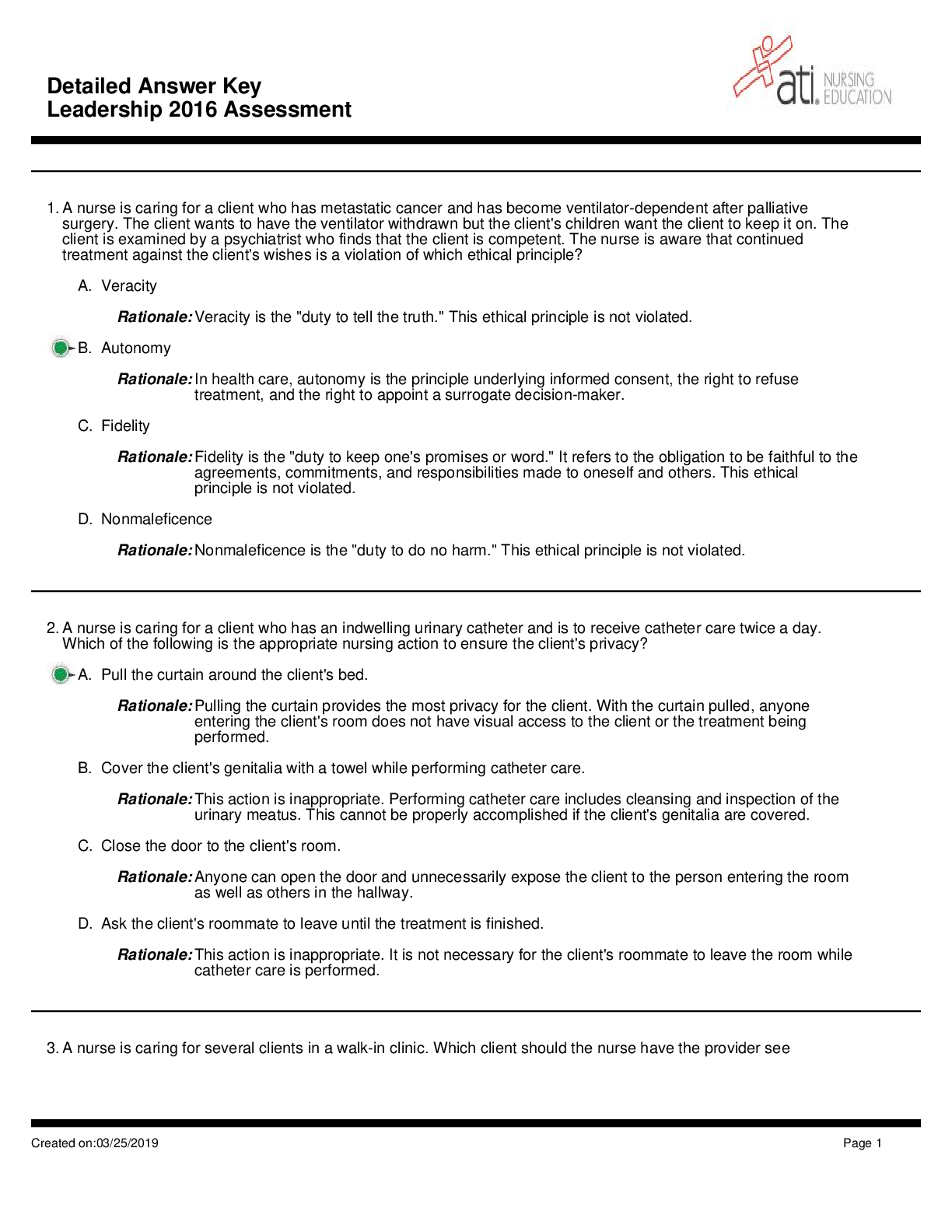
Reviews( 0 )
Document information
Connected school, study & course
About the document
Uploaded On
Aug 17, 2020
Number of pages
29
Written in
Additional information
This document has been written for:
Uploaded
Aug 17, 2020
Downloads
5
Views
274



